The Sailing Seasons Around the World (with Map)
Knowing the sailing seasons around the world help you to plan your trip well. I've made a list of sailing conditions around the world, so you know where to go when.
The sailing season dates for popular destinations:
- The Caribbean: midwinter and early summer (December - January or March - June)
- The Mediterranean: April - October, although the winter is fine as well
- Australia: May - October
- UK: throughout the year
- South Pacific: mostly May - October
But there's more to sailing seasons than just a fixed date. You really have to learn to decide on a day-to-day and year-to-year basis what the best time to go is.
In this article, I'll give you the rough timeframe for the most popular destinations, and after that, I'll dive a little deeper into the different things that make up the conditions of a sailing season. Oh, and cyclone season and hurricane season are one and the same thing - read on to learn why.
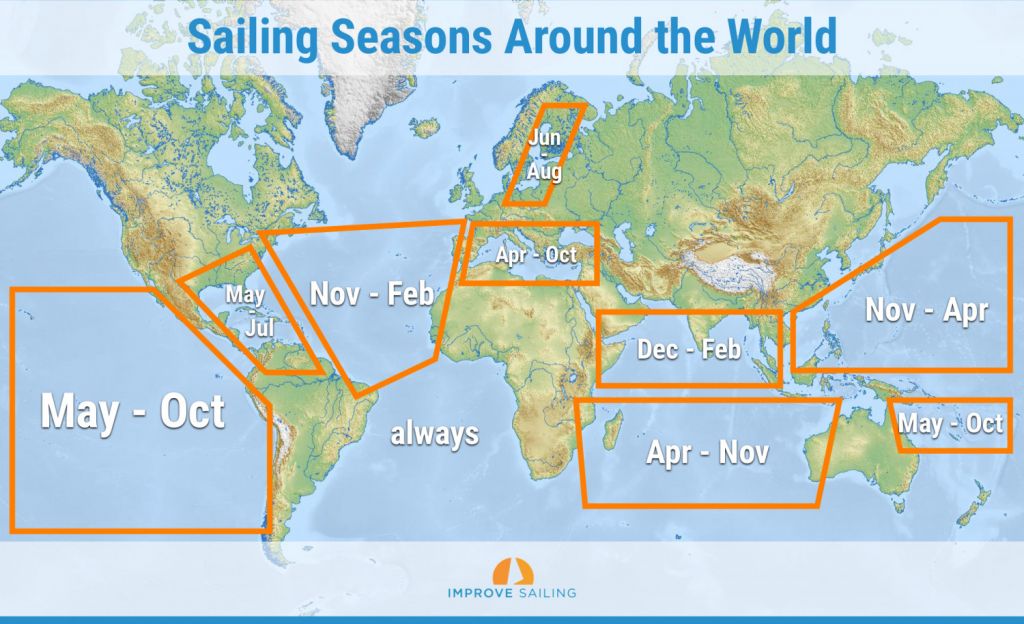

On this page:
Sailing seasons for different destinations, details on the caribbean season, details on the mediterranean season, understanding sailing seasons, what's a sailing season, hurricane's and cyclones, trade winds, related questions.
| Region | Season | Hurricane |
|---|---|---|
| Mediterranean | Apr 1 - Oct 30 | (Aug 1 - Sep 30) |
| Croatia | May 1 - Sep 30 | - |
| UK | May 1 - Aug 30 | - |
| Baltic | May 30 - Sep 1 | - |
| North Atlantic | Nov 15 - Feb 30 | Jun 1 - Nov 30 |
| Caribbean | May 1 - Jul 30 and Nov - Feb | Jul 1 - Nov 30 |
| British Virgin Islands | Apr 15 - Jun 30 and Nov - Feb | Jun 1 - Nov 30 |
| Florida | May 1 - Jul 30 | Jul - Sep |
| Sea of Cortez | Jan - Mar | Aug 1 - Sep 30 |
| San Francisco Bay | Sep - Nov | - |
| Northwest Pacific | May - Oct | Jul - Dec |
| Northeast Pacific | May - Oct | Jun - Oct |
| South Pacific | May - Oct | Nov - Mar |
| French Polynesia | May - Oct | Nov - Mar |
| Australia | May - Oct | Nov 1 - Apr 30 |
| New Zealand | May - Oct | - |
| North Indian | Dec 15 - Feb 28 | Mar - Nov |
| South Indian | Apr 15 - Nov 15 | Nov 15 - Apr 1 |
| Thailand | Nov - Apr | Jun - Oct |
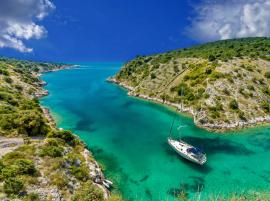
How Long Does it Take to Sail Around the World?
The Mediterranean - The Mediterranean doesn't really have a storm season, although the weather is most unsettled in late summer when the water and land temperature is highest and the air temperatures drop. This causes unsettled weather. I'll go into more detail on the conditions in the Meds below.
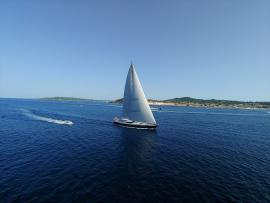
How Long Does it Take to Cross the Mediterranean Sea by Boat?
Croatia - Croatia's sailing season can be limited by the Bora, a North Eastern wind gust coming in from Russia, which can reach hurricane strength. It is strongest in winter. The Bora is a katabatic wind, which means it's a high-pressure wind that comes crashing into the Adriatic Sea through the force of gravity.
United Kingdom - The UK doesn't really have a sailing season, but the racing season runs from Spring - Autumn. But you can sail the coast throughout the year.
Baltic Sea - The Baltic has a short sailing season of 3 months, with extra long days and smooth water. The water, however, is very cold, especially in the first month (June) of the season.
North Atlantic Ocean - The North Atlantic has an active hurricane season running from June to December, with its peak around September. Around January, trade winds are at their best. If you want to know more about the Atlantic crossing, you should definitely read my previous article here. It explains the routes and distance, and the best time to go.
It takes just 2-3 weeks to cross the Atlantic . For a map with the route and some really good tips on how to make use of the trade winds, read my article on the Atlantic crossing here (new tab).
Caribbean - The Caribbean is said to have two seasons: April and November. These are the dryest and hottest months. The peak season is however around Christmas. I'll go into more detail on the conditions in the Caribbean below.
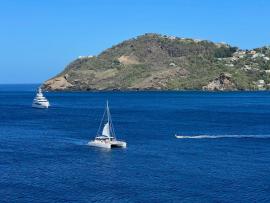
Here's the Best Time to Sail the Caribbean (3 Tips)
British Virgin Islands (BVI) - The calmest period weather-wise is around the winter. The temperatures are moderate, and the winds are moderate. But it will probably rain a little every day - although it's rare to get a full day of rain. This is also peak time, so it's the most crowded and expensive period. Early summer is also a great period since it's a little less crowded and expensive. Temperatures are hot, with light air (less wind than in winter).
Florida - Thunderstorms with heavy winds in the hurricane season. In the summer, nice, moderate winds (5 - 10 knots) with hot and humid weather. A lot of (very big) mosquitoes on the eastern shore locations.
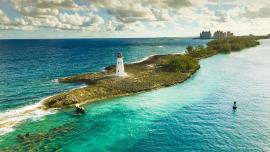
The Best Time of Year to Boat from Florida to Bahamas
Sea of Cortez - The Sea of Cortez sailing season is roughly from November till April, but the peak season is from January to March. Summer, from July - September, is very warm in this area, resulting in storm season at the end of summer.
San Francisco Bay - The sailing weather for the San Francisco Bay area is best around autumn. The weather is clean, with light, predictable winds. Spring is also nice, with good temperatures and visibility. The summer can provide choppy waters, with bad visibility. Fog clouds spread over the bay area, and the winds get unpredictable. There isn't a real storm season here, but there can be an occasional thunderstorm.
For tips on how to sail from California to Hawaii , read my Sailing Guide: California to Hawaii here (new tab).
Northeast Pacific - The Northeast Pacific is the stretch of ocean between Mexico and Hawaii. One of the most active areas in the hurricane season worldwide. Avoid between June - October.
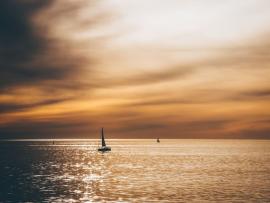
What's the Best Time to Sail Across the Pacific?
Northwest Pacific - The waters surrounding Guam are more likely to be hit by storms from July - December. The Northwest Pacific has a lot of tropical storms, so I recommend to avoid these waters in the hurricane season.
South Pacific - Best time to sail in the South Pacific is from May - October when there are little storms and the weather is settled.
French Polynesia - Full cyclones rarely hit the islands of French Polynesia. The South Pacific doesn't have many strong cyclones.
Australia - The waters North of Australia are prone to cyclones in the season (November - March), from 12 - 25 degrees. There aren't many cyclones outside this area, and if there are, they are almost always well predicted. The waters South of Australia are almost entirely cyclone-free.
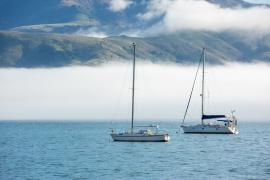
Sailing from Australia to New Zealand (time, route, tips)
New Zealand - Practically hurricane-free.
North Indian Ocean - This ocean doesn't have an official cyclone season, but most storms do form between May and November. 2018 was the most active season since 1992, with 7 cyclonic storms. The best sailing time is during the North East monsoon when the weather is cooler and settled, and the winds are lighter and more predictable.
South Indian Ocean - The most cyclones in the South Indian Ocean usually occur between December - March, but this region is notorious for cyclones outside the season.
Thailand - Thailand has two seasons and no real hurricane season: the dry season (North East monsoon), which runs from May - September, and the wet season (South West monsoon), which runs from October - April. In the dry season, winds are usually stable, come from the Northeast and blow at force 2 - 4. The weather is dry and hot, with an average temperature of 30° C or 85° F. During the South West monsoon, the winds are a bit stronger (roughly 7-8 knots), making for more challenging sailing. Although Thailand doesn't have an official hurricane season, the change of storms increases in the monsoon season (South West monsoon).
Planning a long cruise? I've compiled a list of the most common changes and essentials for ocean passages. Make sure to read my 41 Sailboat Cruising Essentials for Long Trips here (new tab).
Why Does the Season Matter?
You can absolutely sail outside the season, but taking the hurricane season into account will make your sailing experience just generally better. Everything gets easier. You are much less likely to encounter critical situations. Planning your trip according to the seasons will make your trip safer and more comfortable.
So I recommend not sailing outside the season, unless you know what you're doing - and are experienced as a sailor and in weather forecasting.
- General sailing season: Early summer - May 1 - July 30
- Peak season: Last week of December - First week of January
- Temperatures are mild, weather is a bit unsettled, 25-knot winds not uncommon
- Hurricane season: August - September
Best time to go
Although most people will say that the best season to visit the Caribbean is winter, I disagree. Many sailors say that early summer is a great period in the Caribbean. Also, the threat of tropical storms is very much overrated and gets overhyped by the media. Anchorages at the leeward side of the island tend to be pretty well-protected.
May to Late July seems to be a great period to sail the Caribbean. The winds are calmer, the seas smoother, and although the masses like to go to the Caribbean the week after Christmas / before New Year's Eve, it's not the best period. Wind's are known to blow 25 knots throughout the winter period, which is great fun for a day or two, but I can imagine it gets uncomfortable at anchorage pretty quickly.
It's just the best place to be for winter, compared to other sailing regions - but the Caribbean waters are better in early summer, so in my mind, that's the real sailing season.
- General sailing season: Late May - Early October
- Hurricane season: Aug - Sep
- Peak season: Mid July - Late August
The peak season is very busy in the Meds, although there's plenty of places to go and avoid the crowds. It's also the hottest: temperatures may rise to over 35 degrees Celcius (or 95 degrees Fahrenheit). The European West Meds and Adriatic become expensive and very crowded.
The sailing season is a couple of weeks shorter for northern regions. So the northern sailing season runs from Mid April - Mid September :
- France Riviera
- Northern Ionian Sea
- Adriatic Sea
Like in the Caribbean, the peak season of sailing is actually not the best time to be there. I'm not really sure why everybody gets over there in a frenzy in a six-week period. It's so crowded and very expensive. The weather is so hot it's sometimes uncomfortable. I remember one particular summer in early August when I was in Italy; mid-day, temperatures almost reached 40 degrees Celcius (or 104 degrees Fahrenheit). It was insanely hot. An Italian friend kept telling me it was the worst time of year.
Locals all seemed to agree that spring was the best time to be in and around Italy. I agree. The temperatures are mild, really comfortable. True, the waters can be quite cold then, so maybe wait until early summer to go swimming and the like.
Late spring and early summer have a couple of advantages:
- not very crowded
- actual berths available
- a lot of places are less expensive, especially the Italian, and Croatian coast and Greece
- fresh fruit available everywhere
- mild temperatures and good weather
Mediterranean hurricanes are often smaller than full-fledged hurricanes, because the water temperature is a lot cooler throughout the year, making the difference in air temperature and water temperature smaller.
Med. Hurricane's are sometimes called Medicanes. On average, they are about half the size of hurricanes. They create wind speeds of up to 40 - 80 mph (in comparison, a hurricane can easily reach up to 75+ mph.)
They are subtropical storms and not hurricane strength, although they sometimes do reach hurricane strength.
The hotspots for hurricane's in the Meds are the Western Med between Spain and Sardinia and Corsica, and the Ionian Sea, south-east of Malta.
Before you plan any trip, it's important to have a basic understanding of the sailing seasons. Luckily it isn't rocket science and if you understand some basic concepts, it gets way easier to understand weather patterns.
The sailing seasons are usually pretty reliable and don't vary a lot. Knowing the averages gives you a rough estimation and guideline for trip planning. But sometimes even these averages are way off base. The start date of the hurricane season differs every year. For example, in 1938 the North-Atlantic hurricane season started on January 3 instead of June 1.
So it's important to know your stuff and always check the forecasts. You have to be able to determine the season yourself and to do this you need to understand the different factors that make up the sailing season. Every sailor should be able to determine himself/herself when the best time to go is.
So let's dive deeper into what makes up the sailing season and how to call it.
So what exactly is a sailing season? A sailing season is a timeframe in which a certain sea is known to have the best possible conditions for sailing. In this period the water is calm, the winds are reliable, the temperatures are good, and the weather forecast is reliable. The weather is settled - and big surprises are unlikely.
There are several things that decide when the sailing season is. The most important is the number storms you can expect.
Factors that determine the sailing season:
- Winds and storms
- Temperatures
- Reliability of weather forecast in certain periods
If all of these conditions are good, you're good to go. If the weather forecast isn't reliable, it's probably not a great idea to go far out. The Meds are known for unreliable forecasts. This doesn't mean the authorities are not competent, but when the weather in the Meds is unsettled, it can simply change very rapidly. Knowing this helps you to take down a reef or find safe harbor in time.
Here's a map of the sailing seasons per region:
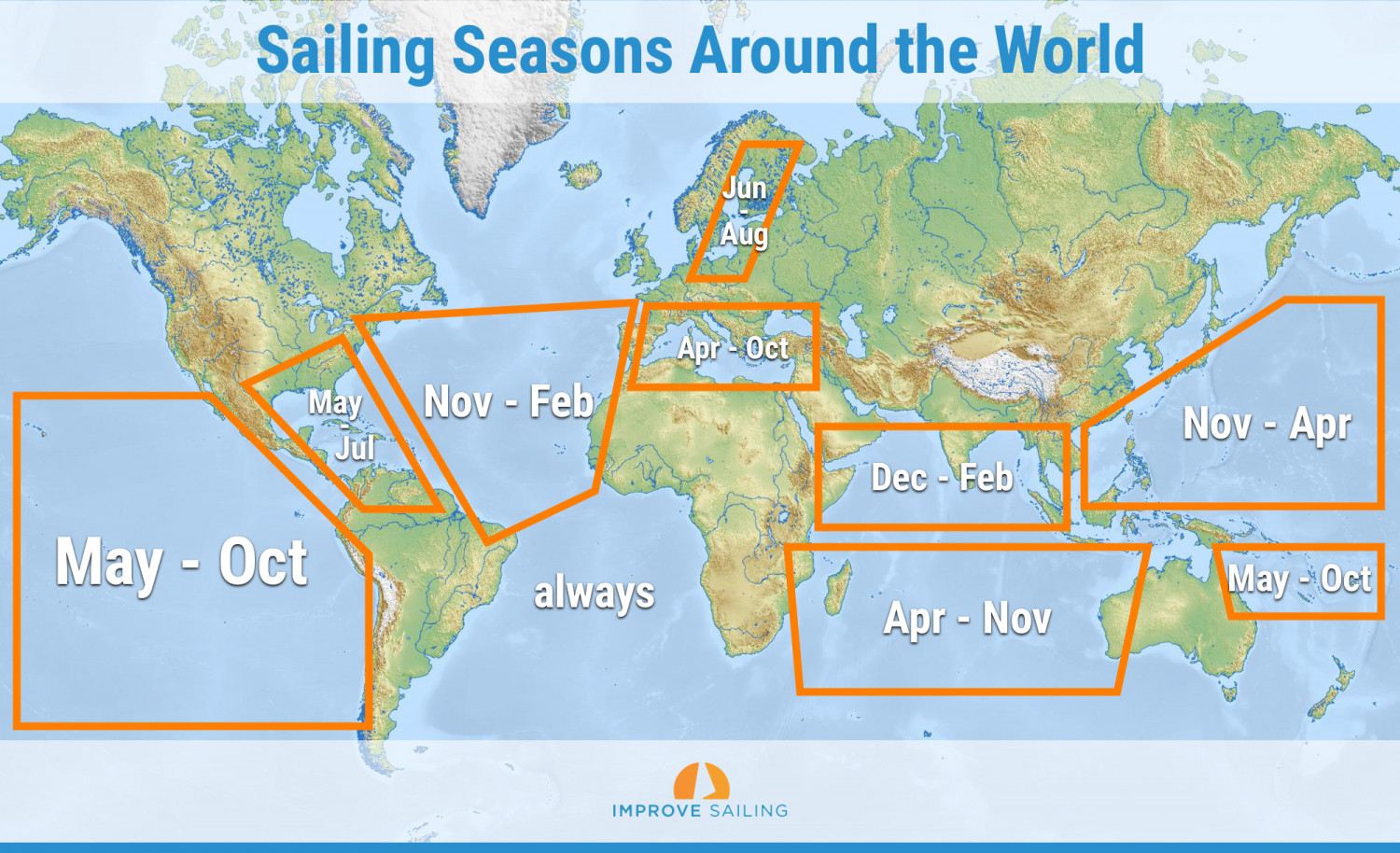
How do hurricanes form? Hurricanes form when the temperature difference of water between the poles and the equator is at its highest, which is in the summer. They form around the equator, where this difference is the largest. The term hurricane is only used in the Northern Atlantic and Eastern Pacific. The scientific term is a 'tropical cyclone'.
Hurricane season is (roughly speaking):
- July - October in the northern hemisphere
- December - April in the southern hemisphere
The hurricane season simply is the period where the worst and most storms will occur.
But this doesn't mean that there are no major storms outside the season. You should always be aware of weather forecasts, even in the hurricane low season.
Here's a map of the hurricanes between 1985–2005:
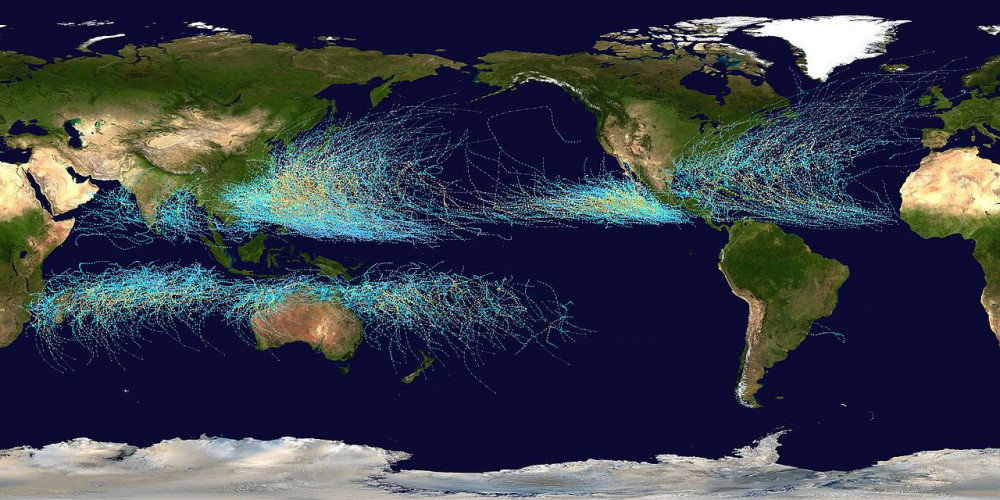
If you want to understand sailing seasons, it's super important to understand a little bit about how wind works. Especially with bluewater sailing, the wind is one of the most important factors that dictate when and where you'll be able to go.
The trade winds are created by the rising hot air around the equator, which then moves towards the poles, cools off, and comes down again. This permanent circulation of air creates steady and reliable winds which are called the trade winds. Near the poles, these winds are generally westerly (they blow from the west) and near the equator, they are generally easterly (they blows from the east).
Here's a map of the trade winds:
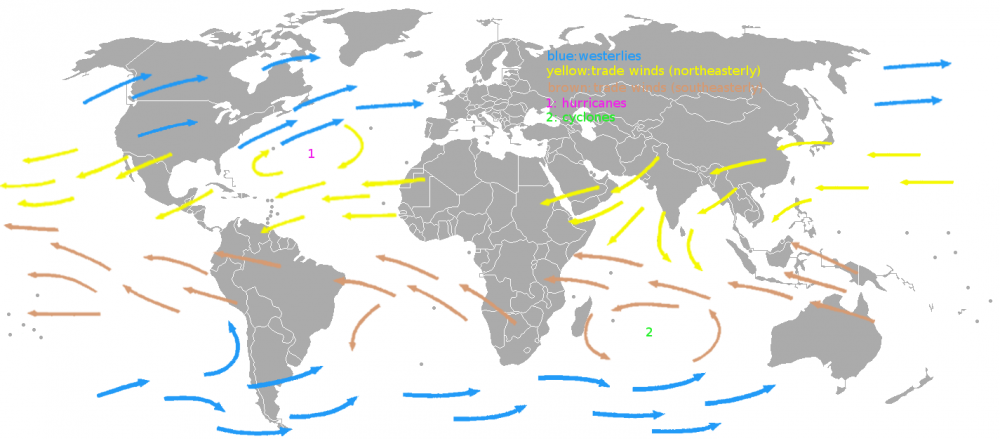
Knowing these wind directions will help you to plan ocean passages more effectively.
How long does it take to sail across Pacific? It takes between 30 - 40 days to cross the Pacific, depending on your port of departure and arrival. It's about 4,000 nautical miles, which is roughly twice as long as the Atlantic crossing. The Pacific crossing is one of the longest ocean crossings possible.
What's the difference between a cyclone and a hurricane? The difference between a cyclone and a hurricane is the location of the storm. Hurricanes' are tropical storms that occur in the Northern hemisphere, while 'cyclones' occur in the southern hemisphere. In the Northwestern Pacific, the term typhoon is also used.
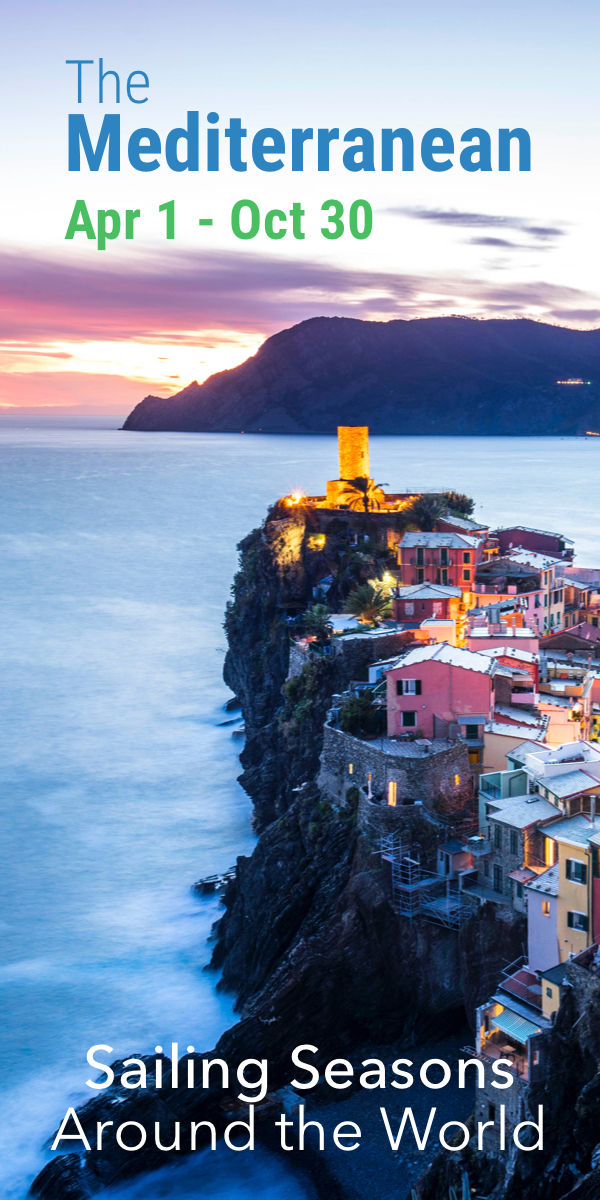
hmm, you need to improve your wording and your limitations on the Australian east coast. Its not ‘south of’ or ‘north of’ Australia. In the North of Australia, 12 to 25 degrees would cover it. Cyclones have been known outside this zone, but they are both rare and well predicted.
Thanks so much for your corrections. It’s always great to get first-hand information from somebody on the ground. I’ve updated the article to reflect your suggestions.
Hi Shawn, interesting articles. On Canary Islands in the Atlantic, one can sail the whole year. The weather is always good, good wind, no humidity, no rain, no cyclones. As the wind comes mostly from NE, it just isn’t always easy to sail back from the westerly islands to the easterly ones. We’ve already spent here 9 months before sailing to Cabo Verde. s/v Silkap www.svsilkap.com
Shawn Buckles
Thanks for the info. Sounds like a nice trip! - Tenerife is one of my favorite places on Earth - I’ve spent two weeks there a couple of years ago. (Your website looks good BTW).
Yeah, Tenerife is special with its highest mountain of Spain. We hope one day (very soon) you can travel full time. There are so many young people sailing around the world, so you have no excuses ;-)
Francisco J Ballesteros Corrales
Do you have an itinerary recomendation from Sea of Cortez to Japan. Season, route? I find info to Hawaii, but not much beyond, i dont know if there is a risk or restriction i do not know about. Great site!
I am having issues reconciling the season/hurricanes between the table and the map for the northpacific.
very informational. thanks. hartelijk bedanktell
I have to move my boat (sailboat 65’) from Los Angeles to North Carolina in 2021. I like to obtain all the information possible for a safe trip. This includes seasonal weather windows, areas and ports to avoid, areas and ports to favor, Best routes after Panama to Florida, yelling inside (ICW) or outside north of the East Coast, etc. Are there any books, publications recommended to consult?
Leave a comment
You may also like.
My big dream is to one day sail the world seas with my wife. But I was unsure how long it actually takes. So I got into it and wrote this article.

How Much Sailboats Cost On Average (380+ Prices Compared)
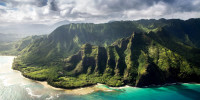
Sailing Guide: California to Hawaii (San Francisco, LA & Seattle)
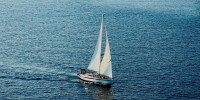
How Long Does it Take to Sail Across the Atlantic? (With Maps)
Better Sailing
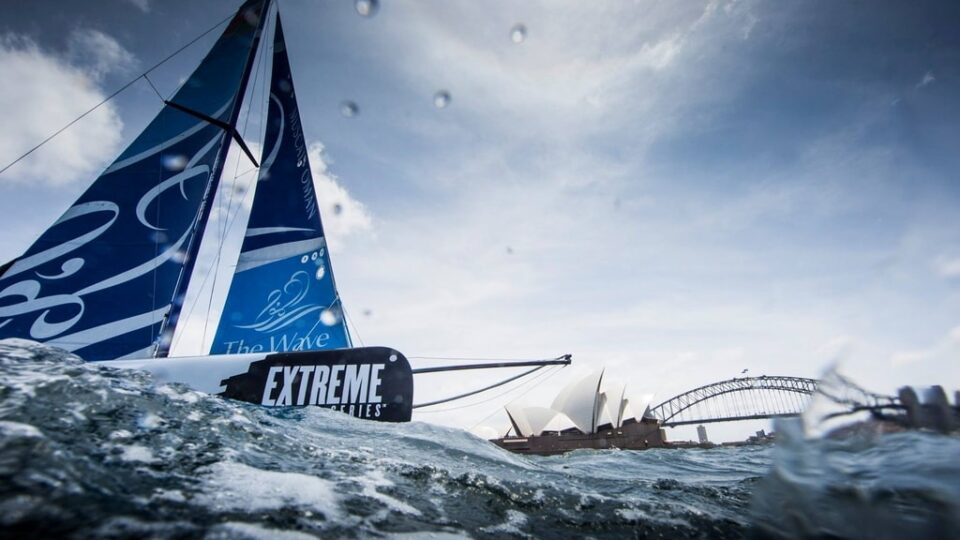
Australia Sailing Guide (With Itinerary)
From the Whitsundays Islands, to Port Douglas, and from Perth to Brisbane, Australia has so many coastal sailing routes to explore. Everyone should spend some time sailing Australia’s deep blue oceans, and the numerous sailing trips offered will ensure that you have as much fun at sea as you did on land. Summer and fall are the ideal seasons for most Aussies to spend time on the water. Despite the fact that Australia is known for being the best destination for water sports, sailing around Australia is a once-in-a-lifetime experience. So, in this article, I will list the best sailing routes and destinations in Australia as well as the most popular sailing itineraries. Keep reading!
Preparing your Voyage: What you Need to Know
With tens of thousands of kilometers of coastline, sailing around Australia or even a portion of it is no ordinary undertaking. If you truly want to sail around Australia, you must have enough time available and be willing to take on a challenge. This is one of sailing’s Holy Grails, on par with an ocean crossing or even completing a global circumnavigation. Because, despite the fact that the Australian coastline is one of the most gorgeous on the globe, it also has some risks.
Keep in mind that you shouldn’t attempt to do this voyage unless you have prior sailing experience . You must also ensure that you have the proper boat and equipment before setting sail. Many people set sail from Sydney, head to Brisbane, and travel up the Gold Coast in an anticlockwise route. Sailing the east coast of Australia includes heading up the Sunshine Coast to Cairns, past the Great Barrier Reef, and around the top of the country, starting in Brisbane. Others set sail from Darwin and explore the west coast. So, it’s important to set your goals and know which part of Australia you want to visit.
Note that when you are planning your stops, you have to consider how far you can sail in a single day. This is dependent on the type of boat you have, the weather, the amount of weight you’re hauling, and a variety of other things. You should strive to be as mathematical as possible because you will need to calculate how much food, water, and other supplies you will require. Naturally, the more you bring, the heavier you will be and the slower you will travel. You can anticipate sailing between 75 and 150 miles every day on average.
Keep in mind that the Northern Territory and Western Australia are remote areas with few ports. So, you’ll need to be well prepared. When you sail down the west coast, you can stop in Perth, the world’s most isolated city, before continuing down the south coast. Keep in mind that temperatures can reach the sweltering 40s, so it’s advisable to have proper ventilation on your boat. This is because if you don’t have adequate protection on your boat, such heat might be extremely dangerous.
Sailing around Australia is a difficult but extraordinary voyage. Note that it might take six to twelve months and include crossing some dangerous waters, such as the Great Australian Bight.
>>Also Read: Is It Dangerous to Sail Around the World?
Sailing in Australia’s East Coast: What to be Aware of
The Australian East Coast is one of the world’s most beautiful travel locations. There are numerous routes you can choose from; from New South Wales to Queensland, and up to Cairns on the Australian East Coast. Note that from April to November, the trade winds blow east-to-southeast in Queensland. But, the winds off the coast of New South Wales can be erratic. Meaning that along the coast, wind patterns tend to change.
One of the most important pieces of advice is to arrange your trip sailing up Australia’s East Coast, particularly in Queensland, to take advantage of the trade winds . While the weather may not always be cooperative, it is far preferable to postpone or go during the appropriate season. The East Coast Trades are quite predictable for running north, especially farther up the coast.
Every sailor understands that the sea is unbeatable. So, always verify the weather forecast and conditions before leaving port. It’s also a good idea to double-check immediately before leaving. This is because weather conditions may have changed since the forecast the night before. While conditions in a peaceful anchorage may appear calm and relaxed, there might be harsh wind and wave conditions just over the headland.
Furthermore, tropical cyclones can occur in the Queensland region as a result of lows in the monsoon trough. It is often discouraged to sail in Far North Queensland between November and April. During this time of year, many full-time cruisers prefer to travel south to NSW. The south-easterly trade winds die out during this season, making sailing south much simpler.
Note that the ruins of Australia’s once-thriving island tourism sector can be found as far south as the Whitsundays. Unfortunately, the vast majority of the island resorts seen sailing up Australia’s east coast have been abandoned. This is due to Australia’s high travel costs compared to other countries, as well as the risk of tropical storms in the north. Regardless, those traveling up the east coast will have the opportunity to visit islands that have been cut off from the rest of the world for generations.
Whale Migration in Australia
It’s known as the Great Humpback Whale Migration in Australia. Approximately 60,000 humpback whales depart Antarctica each year to undertake their own northward voyages. It’s the world’s largest animal migration, taking three months to reach northern Australia. In the warm tropical waters, they breed and raise their babies. Whales go north during the months of July and September. And, they travel to the south from September to January. If you’re cruising up Australia’s East Coast during the whale migration, you’ll almost surely see a lot of them. This has the potential to be both a blessing and a curse.
This is because sailing at night can be dangerous, since the whales snooze on the surface, entirely unaware of sailing vessels. When sailing up Australia’s East Coast, many individuals have experienced “bumping” whales. It will not be a nice experience for you, and it will be even more unpleasant for the whales.
Sailing Along Australia’s East Coast
While the sea and its bays are must-sail areas, island hopping is also great on Australia’s East Coast. These are the best islands in the Queensland area:
- Whitsunday Islands (Keswick, Brampton, Goldsmith)
- The Low Isles, Port Douglas
- Hamilton Island, Whitsundays
- South Molle Island, Whitsundays
- Green Island, Cairns
- Great Barrier Reef Cays
- Magnetic Island, Townsville
- Dunk Island, Mission Beach
- Orpheus Island
The places you will stop are the nicest part about sailing on Australia’s east coast. The following is a list of some of the best anchorages and mooring spots along the Queensland coast:
- Whitsunday Islands (Brampton, Outer Newry, Goldsmith)
- Whitehaven Beach, Whitsundays
- Cid Harbour, Whitsundays
- Airlie Beach
- The Hinchinbrook Channel
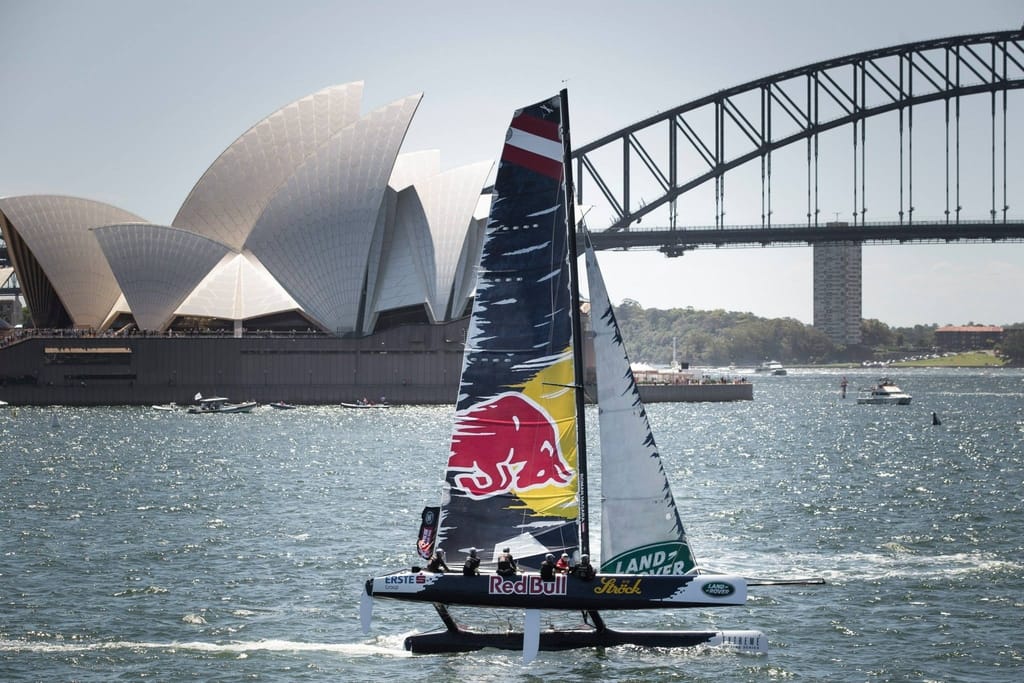
Sailing in Australia’s East Coast: Tips
Keep in mind that full-time cruising in Australia can be expensive. But, if you catch your own fish, use the wind for propulsion, and anchor for free, the cost is significantly lower than living on land. Diesel and food will be the most expensive items on a daily basis, and the amounts will fluctuate based on your food needs and how much you use your engine. Expect to pay between $70 and $140 a night for docking and marina fees. So, consider spending 99 percent of your time anchoring since it is entirely free.
It’s worth noting that the sailor who claims to never experience boat troubles has never left the harbor, as the adage goes. In other words, always keep in mind the possibility of having to pay for repairs. From the engines to the sails, electronic equipment to leaks, every boat may have issues.
There’s a joke that when you cruise the east coast is like “sailing with a watch in your hand”. This is because many of the openings are river mouths with sandbars across them, necessitating precise calculations to cross the bar at low tide.
The navigating difficulties can be summed up in three words: current, depressions, and a strong sea breeze.
First, there’s the current. There is a southbound current of up to four knots along Australia’s east coast. This makes for rapid sailing to the south but tedious labor up north unless you employ the countercurrent near inshore. The Leeuwin current flows east at 0.5 knots along the south coast. Also, the Leeuwin current is stronger on the west coast, flowing south at around one knot. The depressions are the second difficulty. They move from west to east in a constant stream, bringing troughs and fronts with them. The available forecasts are of great quality, so you can make use of the wind generated by the depressions to propel you in the appropriate direction.
Going against the prevailing winds, however, might be difficult because of the rapid build-up of steep wind waves in shallow coastal locations. Note that sea breezes are generated by Australia’s scorching interior. Again, if you use the winds effectively, you can enjoy sailing on great routes. However, you must always be cautious. On top of the prevailing winds, sea breezes can easily last for 12 hours and reach speeds of over 25 mph.
Also Read: Best Small Sailboats To Sail Around The World
Sailing in Australia’s East Coast: Common Itineraries
Australia’s East Coast is the most popular tourist destination in this breathtakingly distinctive country. Cairns, the Whitsundays, Fraser Island, Brisbane, and more are among the top destinations. Coastal communities, sandy beaches, and numerous national parks, notably the Great Barrier Reef Marine Park, are all well-known. The regions there are warm and the nicest aspect about cruising Australia’s east coast is that there won’t be any nighttime passages for a while!
Between Sydney and Cairns, the east coast offers the chance to sail during the day and overnight at various marinas, yacht clubs, and sheltered secure anchorages. While cruising in these areas, you will get to meet some local cruisers who will be delighted to share their experiences and pass on any suggestions or local information they may have. I’m sure you’ve heard folks talk about how beautiful the Great Barrier Reef’s cruising grounds are. Well, they are correct! And, exploring the islands and sheltered seas of the Great Barrier Reef and coastal Queensland for a few months (or perhaps years) should be on almost everyone’s sailing plans.
Depending on the distances you’re willing to travel, you have a variety of options. Making landfall near Brisbane in Queensland and sailing south to Sydney and back is a popular alternative, as is continuing sailing to Tasmania. The Australian east coast has a lot to offer in terms of diversity. Because the distances between ports are often short, you can daysail your boat from one to the next. Crossing Bass Strait is always a challenge, but the effort is well worth it when you see Tasmania’s beautiful environment and scenery.
In addition, many people start their voyage from Cairns, Thursday Island, or Darwin on Australia’s East Coast. Visits to the Whitsunday Islands and the Great Barrier Reef are a must on this route.
If you sail from Bundaberg to Sydney and back up the east coast to Darwin, you’ll feel a sense of accomplishment when you arrive in such a famous port. On the route, there’s the Great Sandy Strait, which runs between the Sunshine Coast and Bundaberg. It’s between the mainland and Fraser Island and it’s a beautiful and scenic place ideal for sailing. The water is crystal clear, similar to the Whitsundays, and it’s one of the best places to spend some days relaxing. Whales, dugongs, dolphins, and turtles are among the marine fauna that may be found in the Great Sandy Strait. And, this is why it is designated as a marine sanctuary.
These are the most common itineraries for sailing along the East Coast of Australia. Keep in mind that you can sail clockwise or anticlockwise.
- Melbourne, Wilsons Promontory, Eden (NSW), Bermagui (NSW), Jervis Bay, Cabbage Tree Bay Marine Reserve, Manly, Sydney, South Solitary Island, Gold Coast, Brisbane, Sunshine Coast, Great Sandy Strait, Bundaberg, Mackay, Airlie Beach, Cairns, and Lizard Island.
- Cairns, Mission Beach, Townsville, Airlie Beach, Mackay, Rockhampton, Agnes Water, Hervey Bay, Rainbow Beach, Noosa Heads, Great Sandy Strait, Maroochydore, Moreton Bay, Brisbane, Gold Coast, Tweed Heads, Byron Bay, Port Macquarie, Sydney.
Sailing in Australia’s West Coast: What to be Aware of
Western Australia is bordered on the east by South Australia and the Northern Territory, and on the west and north by the Indian Ocean. The southwest coastline region has a mild climate. The state’s middle four-fifths are semi-arid or desert. Annual rainfall ranges from 200 to 250 millimeters, with the majority falling in intermittent torrential downpours during cyclone outbreaks during the summer months.
The northern tropical zones are an exception to this. Kimberley has a relatively hot monsoonal climate, with annual rainfall ranging from 500 to 1,500 mm on average. However, there is a lengthy, practically rainless season from April to November. The Kimberley receives 85 percent of the state’s runoff.
In Western Australia’s northwestern region tropical cyclones are a common phenomenon. They occur from November to April, with sporadic activity in the months before and after. The highest occurrence takes place in January, February, and March. Squalls are prevalent, especially during cyclone transitions. They affect all areas north of Carnarvon, including all land and sea areas in Northern Australia. But, areas south of Carnarvon are not affected that much.
Cyclones strike Western Australia’s northwest coast more frequently than any other region of the country’s coastline. It has one of the world’s most cyclone-prone coastlines. Each year, several tropical cyclones form, but only two cross the coast of northern Australia on average. The tropical cyclone season runs from November to April, with the majority of coastal crossings taking place in February and March.
Sailing in Australia’s West Coast: Passages
Bear in mind that currents have a wide range of speeds, ranging from 3 to 1 knot, but reaching up to 3 knots in some regions. The best time to visit is from May through October, which coincides with the dry season. Weather conditions are warm to hot, with low humidity. The SE trade winds blow from E to S, averaging 4 to 5 mph during the day and get stronger at night. In the southern region, anticyclone systems tend to increase the wind’s strength. However, the trade winds are frequently linked to pleasant weather.
Tropical storms do occur on occasion. During this season, excellent weather conditions prevail, with regular light conditions in the northwestern parts. This will result in using your motor more frequently. You should carry extra water and fuel in the Kimberley region, from Broome to Darwin, as supplies are spread out over vast distances. During the dry season, strong SE to SW winds are common for regions south of Exmouth. Meaning that your voyages south will be more difficult. If you intend to head south, it is best to wait for a high system with moderate E to NE winds. Excessive tides and strong tidal streams up to 4 knots (but up to 10 knots at the approach to major bays and narrow channels) are common in the NW.
When navigating and choosing anchorages, extreme vigilance is essential. There are numerous unmarked “bombies” (an area of large sea waves breaking over a shallow area) and shallows around the coast. In other words, you have to be cautious and plan careful navigation.
Sailing Trip in Australia’s West Coast: Tips &Common Itineraries
The most common locations you can set sail on Australia’s west coast are Darwin or Kimberley. Note that May through October are the best months to cruise in the Kimberley area. When there is a strong high to the south, SE winds are predominant in the morning and can reach 30 kn. In the afternoon, the wind normally dies down. Furthermore, note that most anchorages are best visited during a period of neap tides.
If you’re traveling north , April/May is the best time to leave Fremantle for the Abrolhos, Shark Bay, or farther north and east. If you’re heading to Queensland, plan on arriving in Darwin by the end of September. A voyage from Fremantle to Kimberley and back needs to sail rapidly. Also, it is possible to leave Carnarvon in the first week of May if no cyclone is building.
When traveling to the Western Australian coast, June/July is a great time to leave Darwin. When heading south to Fremantle, plan to get at Dampier by early September. Keep in mind that the best time to travel from Broome to Dampier or vice versa is when a fairly strong front is nearing the south of the state. You should do this in suitable weather and avoiding strong E winds. In September, a vessel sailing south from Dampier should expect moderate southerly quadrant winds for the remainder of the journey down the west coast.
You should aim to arrive in Geraldton by the end of September. This is because if you arrive later the risk of strong southerlies will increase. Coming south from North West Cape normally entails a lot of windward effort. So, a day or two in a peaceful anchorage is essential. Continuing south from Geraldton, the goal is to leave in September or October. It’s a good time so as to avoid winter cold fronts but not late enough to dodge the strong southerly summer sea winds. Short and sparse weather windows are common. April-May is the best time to do this passage.
These are the most common itineraries for sailing along the West Coast of Australia. Keep in mind that you can sail clockwise or anticlockwise.
- Kimberley Coast, Pilbara Coast, Ningaloo, Gascoyne and Geraldton Coast, Abrolhos Islands, Lancelin, Perth, Bunbury, Leeuwin Coast (Cape Naturaliste to Cape Leeuwin), Albany, Esperance and Eucla Coast.
- Darwin, Wyndham, Derby, Broome, Port Hedland, Dampier, Exmouth, Carnarvon, Geraldton, Fremantle, Bunbury, Albany, Esperance.
The Great Australian Bight and the Southwest Coast
In general, the best months to cross the Bight from west to east are October to November or late March to roughly mid-April. It’s worth noting that every year is a little different, so anyone planning a trip should start checking weather patterns a few weeks ahead of time.
There is also a less-traveled route that circumnavigates Australia’s south and west coasts. The difficult westward crossing of the Great Australian Bight is possible in the summer months of February and March after carefully examining weather patterns. This is because the predominant south-westerly winds are chased away by a series of high-pressure systems. And, this results in four to seven days of pleasant easterly winds. A voyage “down the bottom” of Australia not only allows you to visit Tasmania’s lesser-known cruising locations on the untamed west coast, but it also allows you to visit cities like Adelaide.
From Adelaide to the natural splendor of the Gulf St Vincent and the Spencer Gulf with its various anchorages, the south coast of Australia is a particularly pleasant cruising ground . Western Australia offers a very different cruising experience once you’ve crossed the Bight. Long reefs lie throughout the coast, necessitating cautious navigation. Cities such as Perth and Fremantle provide all amenities to boats. Note that there are two possibilities from Australia’s west coast if you want to continue your voyage. Either you will start crossing the Indian Ocean as soon as possible after the cyclone season ends, or sail north to Indonesia.
Australia Sailing Trip Guide – The Bottom Line
In the last decade, an increasing number of cruisers have seen Australia as a stand-alone destination. And that opens up a whole new world of possibilities. A downwind voyage of roughly 700 miles from New Caledonia to the east coast of Australia is far more comfortable than the difficult 1,000-plus mile crossing from the Pacific Islands to New Zealand. In any case, Australia is a huge country, so don’t underestimate the distances you’ll have to travel. For example, the distance from Bundaberg to Sydney is just under 500 miles, and the distance from Sydney to Hobart is 628 miles. Traveling over the Great Australian Bight from Hobart to Perth will add additional 2,250 miles to your journey.
If you want to sail around Australia you can either get back home and store the boat in Australia or continue sailing. The most important thing to remember is to stay below 30 degrees south latitude. This is because the official cyclone belt is located to the north of this latitude. In other words, you can continue sailing and explore the Australian seas rather than waiting for the cyclones to pass. Cruising Australia’s coastlines may be extremely rewarding: the wildlife, natural beauty, diversity, and warmth will astound you.
I hope that this article was helpful to your route and voyage planning for sailing around in Australia. I wish you all safe & pleasant voyages!
Peter is the editor of Better Sailing. He has sailed for countless hours and has maintained his own boats and sailboats for years. After years of trial and error, he decided to start this website to share the knowledge.
Related Posts

9 Breathtaking Places to Visit while Sailing Across The Greek Ionian Islands

Unveiling the World’s Best Fishing Secrets: 10 International Hotspots for Anglers
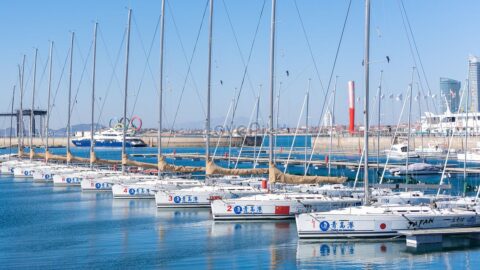
Sailing in Qingdao, China: Exploring the Coastal Charm

Best Spearfishing Spots in California
- Buyer's Guide
- Destinations
- Maintenance
- Sailing Info
Hit enter to search or ESC to close.

Berthon Winter Collection

Latest issue

August 2024
In the August 2024 issue of Yachting World magazine: News Few finish a tempestuous Round The Island Race European rules are eased for cruising to France and Greece Olympic sailing…

- Yachting World
- Digital Edition

Cruising Australia’s east coast: ‘A delicious mix of modern convenience and truly isolated’ adventure
- April 19, 2024
Unexpected challenges pushed Saskia Stainer-Hutchins and husband to their limit while bluewater cruising in the capricious waters of the Australian east coast

When we tell people we’re bluewater cruising around the world , the first question is almost always the same: ‘What about storms?’
I’m hesitant to reinforce a Hollywood dramatised view of life at sea so keep a practised response to hand: ‘We plan ahead and use lots of forecasting tools to avoid bad weather, so see it rarely.’
But my answer to where we have experienced the most challenging weather – so far – may surprise you: Australia.

Strong winds and driving rain were no fun north of Cairns. Photo: Saskia Stainer-Hutchins & Ross Rodrigues
I should caveat this with an observation: everyone sails their own course. Having met many cruisers in over two years as a liveaboard, I’ve realised that no experience is universal.
Sailing contains so many variables that every passage is different. I should stress that Australia was one of our favourite overall cruising destinations. Did it push us to our limit?
Absolutely. Would I encourage you to go? I would say that it cannot be missed.
Bluewater cruising around Australia
Firstly, Australia is massive. The Australian coastline is over 16,000 miles. You want to sail all of it? It would take years.
More than 85% of Australians live on the coast; it’s integral to their way of life. Australia is also a nation of sailors. There are modern marinas in nearly every town and every boat service you can imagine is easily accessible.
For us, this was a key draw; it was an important stop off on our bluewater cruising world trip to conduct some much-needed maintenance and repairs.
After almost a year sailing our Lagoon 46 Acushnet in the South Pacific, I’d be lying if I didn’t admit to breathing a sigh of relief to be back in the modern world.
Luxuries like direct delivery, Uber and, best of all, crisp salad, made travel more enjoyable by relieving some of the stresses of bluewater cruising life and left us with more time for exploring.

Photo: Saskia Stainer-Hutchins & Ross Rodrigues
We sailed into Australia from New Caledonia at the start of the cyclone season in November 2022, and spent three months in a yard just south of Brisbane.
By February, we were itching to head back out to sea and explore but were hampered by our insurance which would not allow us to go higher than 27° south before the cyclone season broke in April.
As a result, we turned south, keen to view iconic Sydney Harbour from the bow of our own boat.
For anyone who’s had even a passing interest in the Rolex Sydney Hobart Race it’ll come as no surprise to learn that Australian weather can be unpredictable at best.
These challenging conditions are largely thanks to the currents of the Pacific and Southern Oceans, each of which have varying temperatures.
Where the waters meet, in the Tasman Sea, the waves swell, and storms develop quickly. As a result, these waters can be extremely rough and unpredictable.
This was our first lesson on leaving port. Despite a clean bill of health from a weather router, and every PredictWind model available, we hit bad weather mere minutes after pulling out to sea.
The worst lightning storm of our lives enveloped us instantly, with the closest strike around 60m from the boat – I saw it touch water.
Day two of our three-day bluewater cruising passage was spent ploughing into giant waves, churned up as wind opposed the famous East Australian Current.
The whole journey ended with an impressive finale; a sustained 45-knot storm, gusting over 50, that lasted six hours.

Our top boat speed, in our 22-ton catamaran, was 18 knots. Mercifully, the boat handled it all beautifully and nothing was damaged.
Once the weather had passed, we sailed into Sydney at 0400, and there was something eerily beautiful about slipping into such a busy port in its quietest hour after such a tempest. It felt like we were the only ones to see the city wake that morning.
Anchoring with big city life
I’d called no fewer than 68 marinas in Sydney and its surrounding area to try and secure a berth or a mooring ball, and eventually came up trumps with a sub-let slip (from a megayacht, no less) that overlooked Sydney Harbour Bridge.
We toasted our safe arrival with champagne bought at the fancy restaurant next door.

Sailing under Sydney Harbour Bridge and past the Opera House. Photo: Saskia Stainer-Hutchins & Ross Rodrigues
We enjoyed the perks of big city life, from our own floating home, for a week. Australians are thalassophiles, so it was oddly comforting to find ourselves in a city of like-minded people.
It’s a place where the working day starts with a quick surf and childcare is often the local ocean swimmers club.
A real highlight was walking the Coogee to Bondi cliff path, which finished with a dip at the famous Bondi Icebergs saltwater pool, fed by waves that crash over its edges. It made for a deliciously cold dip after a long and sweaty walk.
We left Sydney in the middle of the day and finally got our ‘pinch me’ moment as we steered Acushnet under the Harbour Bridge and out past the Opera House.
It’s hard to describe the feeling of accomplishment we experienced in that moment. Back in Florida, Sydney felt impossibly far away and sailing there a pipe dream of epic proportions.
I can still hardly believe that we did it.

Our next port of call was Pittwater, perhaps the most picturesque bluewater cruising destination in New South Wales. Only 20 miles or so north of Sydney, it’s a popular choice for the city’s sailors.
The area boasts several large yacht clubs and marinas, so this was where we planned to leave the boat while we also fitted in some land-based travel.
The bluewater cruising area was exceptional. One highlight was sailing into Refuge Bay, a beautiful anchorage topped with a gentle waterfall.
The 100 or so mooring balls were an indication that at weekends this spot would be packed, but midweek we had it all to ourselves.
We thrashed our way through undergrowth and climbed a vertical cliff, to be rewarded by a series of natural pools where we could bathe overlooking the anchorage. The area is part of a national park, and we also passed Aboriginal rock art.

Bondi Icebergs Swimming Club, Sydney. Photo: Saskia Stainer-Hutchins & Ross Rodrigues
Quick-stop cruising
After crossing the South Pacific, it seemed to us an audacious luxury to be able to day-sail our way across Australia. We cruised over 2,000 miles up the coast from Sydney to the Torres Strait but made only a few overnight passages.
Along the way we discovered endless quirky towns and unique anchorages.
We found an island where a couple lived off grid, sharing their wild honey with passing sailors in exchange for any odds and ends they needed.
We spent three nights inside Fairfax atoll, which was completely covered at high tide, and with no wind felt like we were anchored in the middle of a flat ocean, totally alone.
We swam with minke whales while scuba diving on the Great Barrier Reef.
We chased dingoes from a 4×4 on K’gari Island, snorkelled with more fish than I have ever seen in my life at Tangalooma wrecks, and rode jet skis up the swampy river of Cairns, spotting massive man-eating saltwater crocodiles along the way.

The sailing conditions were usually an extremely pleasant 15-20 knots on the beam or behind, giving us the chance to experiment with our methods.
On a typical day we’d play around with our light wind sails (a Code 0 and a Wingaker parasail), hoisting one after the other as conditions changed.
Knowing we didn’t have to race to port allowed us to simply saunter along with the sails up and no engine, even if we only made 3 knots.
Around Southern Queensland we found that the shifting sands made the Navionics maps unreliable, and nearly ran aground twice. These same conditions created some dangerous sandbars at the entrances to otherwise safe harbours.
On one memorable occasion, a volunteer in a lighthouse coached us on VHF into Mooloolaba Marina where surfers were riding breaking waves crossing the entrance channel.
The tactic was to count the sets and then gun it in. This part of Australia also had fairly high tidal range; the largest we saw just over 7m. This made dinghying to shore difficult at times and so tide tables often governed the rhythm of our days.
Whitsunday waters
After a month or more of bluewater cruising from Sydney, we finally made it to Australia’s most famous cruising ground, the Whitsunday Islands. Once there, it’s easy to see why it’s so popular.
There are 74 islands, and this densely packed archipelago lies between the north-east coast of Queensland and the Great Barrier Reef. Most islands are uninhabited, and characterised by dense rainforest and white sand beaches.
We have scuba gear on our boat and spent many happy hours simply jumping off the stern to explore the thriving ecosystem below.

Wrecks at Tangalooma, scuttled in the 1960s and 70s to provide a breakwater, teem with marine life. Photo: Saskia Stainer-Hutchins & Ross Rodrigues
One day we dropped anchor behind the famous ‘hill inlet’, at the northern end of Whitehaven Beach.
The sheer number of tourist boats in Tongue Bay when we arrived was dream-crushing, but long before sunset each one departed, leaving us alone.
We seized the opportunity to take the hike up to the viewpoint and had the breathtaking sweep of landscape all to ourselves. As the crowds had gone, we even got to see the notoriously shy Proserpine rock-wallabies playing on the path.
Beyond the Whitsundays our next port of call was Cairns.
Here we had to make up some time by doing this as a three-day passage, skipping some favourites (such as Magnetic Island) on the way, as we were racing for a flight I needed to take to sort out my US visa.
In contrast to our earlier lazy island-hopping pace, with zero knots of true wind we found ourselves motoring the entire way: sailing on a schedule is not fun.

The Whitsundays are arguably Australia’s most famous cruising grounds, with crystal clear water, densely packed islands and stunning wildlife. Photo: Saskia Stainer-Hutchins & Ross Rodrigues
Cairns, a city of only 150,000 people, was going to be our last major population centre until Singapore six months later.
Beyond here the Australian towns get smaller and finally peter out around Cooktown, 200 miles north, where the road stops. We used our time in Cairns to provision heavily, stuffing six months’ worth of oat milk in the hold.
It was also a last chance to lean on the services of trained boat professionals, with much of our time spent installing a brand-new set of high-performance sails. This, it turns out, was not a good idea.
Averting disaster
After Cairns we threaded our way up the coast, stopping at Port Douglas to see the Daintree rainforest, and some smaller coves to ease the run north.
We made it to Cooktown, a small frontier town in far north Queensland, in early July, and spent a memorable night in the local RSL club – which was certainly the liveliest spot in town (population: under 3,000).
After that, civilization stops. As we pulled out to sail the remaining 350 miles up the deserted coast of Far North Queensland, it felt like we were falling off the edge of the world.
This stretch of coastline is notorious for strong wind at that time of year, so we planned to only stop a few times on our ride up to Cape York, the tip of Australia, to make the most of a reasonable weather window.
For the first four days we made excellent time, bluewater cruising downwind in 25-35 knots.
But once when we were truly miles from any help, disaster struck. At about 0300, the shackle on our new jib failed.
As winds had been blowing for 25+ knots for over a week, the waves were massive.
It took nearly an hour in driving wind, rain, and darkness for the two of us to get the sail under control, by which time the clew board had shredded that corner of the sail as it thrashed around.
To make matters worse, we were in a narrow shipping lane with reefs on both sides and cargo ships passing.

‘Tide tables often governed the rhythm of our days’. Photo: Saskia Stainer-Hutchins & Ross Rodrigues
As dawn started to leak across the moody horizon we scanned the charts, looking for a safe anchorage to pull in.
As luck would have it, there was a creek (croc-infested, of course) less than 50 miles further up the coast and we made our way in just before sunset.
Completely on our own, we spent the next three days repairing the sail before we were able to hoist again and tentatively poke Acushnet ’s nose back out to sea.
The wind, utterly disinterested in any nerves we felt after our misadventure, continued to blow at a steady 28 knots.
It wasn’t until we finally turned around the lee of Cape York, two days later, that I could relax. I slept for 14 hours that night.
When people ask me about storms, I think they largely imagine the boat somewhere in the middle of the sea.
Having ridden out heavy weather on both the coast and the open ocean, where you are does not matter – at least, not with regards to the level of fear you feel in that moment.
The friendly lights of Sydney did not comfort me when we rode a storm exiting her harbour.
In far North Queensland, the proximity of the reef made our experience extra dangerous; if we’d lost control of the boat we could easily have been wrecked on rocks.
Article continues below…

What’s it like to quit your job and sail the world?
There’s an old sailing joke that goes something like this: “In search of single man with boat. Please send photo…
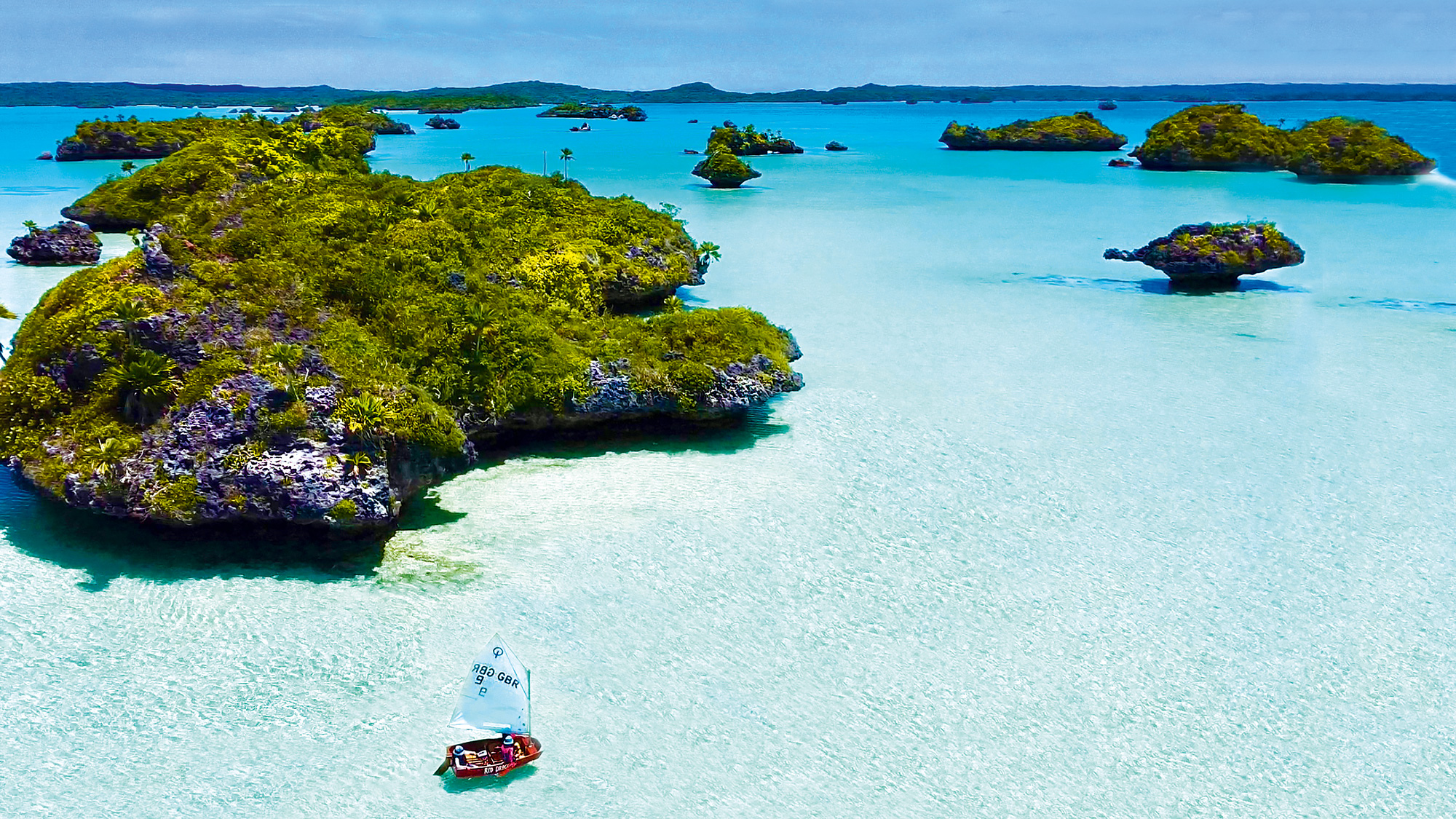
Sailing halfway around the world: one family’s cruising adventure
After a fast downwind passage from French Polynesia, we sailed into Fijian waters, just under 12 months after setting off…
To Torres and beyond
The second stage of our Australian adventure was a lesson in self-sufficiency.
During most of our trip we were within easy hailing distance of professional help should anything go wrong, and for months we’d made the most of this fact. But world cruising is mostly not like that.
Our own hands and a little YouTube research are all we have in most fix-it situations. Australia can truly deliver the full gamut of that bluewater cruising experience, offering both modern cities and remote wilderness all in one (very large) country.

Fixing the jib after it blew out in far north Queensland, miles away from civilization. Photo: Saskia Stainer-Hutchins & Ross Rodrigues
Our last stop, before our jump to Indonesia, was the Torres Strait islands, half a day’s sail from the Cape.
This archipelago of over 270 islands dotted between northern Australia and Papua New Guinea bore a strong resemblance to the communities we met in the South Pacific, and I had to constantly remind myself that we were still in Australia.
The waters were a picture-perfect cyan blue and deceivingly inviting. However, given the numbers of crocodiles, locals advised that we should not even risk getting into the dinghy tender at dusk.
It was the season to cross to Indonesia and we were welcomed into Thursday Island by a large group of world cruisers. We’d not seen much of this community in Australia as many yachts circumnavigating had instead pulled down to New Zealand for the cyclone season.
But I wouldn’t have missed our Australian adventure. After 20,000 miles (and counting), it remains one of my favourite bluwater cruising grounds.
It was a delicious mix of modern convenience and truly isolated last-frontier-esque adventure. The wildlife was unique. The landscapes were breathtaking. And the sailing… well, the sailing was undeniably challenging.
But for us, this round the world voyage is about seeking the path less travelled and taking on challenges that will test us. Those are the experiences that will move us and the lessons that will shape us. Australia made us better sailors, and I cannot ask for a greater gift than that.
If you enjoyed this….
Yachting World is the world’s leading magazine for bluewater cruisers and offshore sailors. Every month we have inspirational adventures and practical features to help you realise your sailing dreams. Build your knowledge with a subscription delivered to your door. See our latest offers and save at least 30% off the cover price.
- Food Recipes
- New Food Releases
- Where to Eat
- Beer & Wine
- Drink Recipes
- New Drink Releases
- Where to Drink
- The Weekender
- Travel Australia
- Travel the World
- Beauty & Skincare
- Health & Wellness
- Sustainable
- Valentine’s Day
- New Years Eve
- Cars & Sport
- Film & TV
- Music & Podcasts
- What’s On
- Finance & Insights
The Top 10 Destinations For Sailing in Australia
Looking for the best places to sail in Australia? Now has never been a better time than to set sail on a new adventure.
For most Aussies, summer and autumn calls for the perfect season to spend time on the water.
Although we’re renowned for being the best destination for water activities, sailing in Australia is an experience like no other.
So whether you’re looking for a sailing holiday or simply just the top sailing destinations, these top 10 places to sail in Australia will have your weekends sorted!
When is the best time to sail in Australia? Thanks to the balmy weather and the calming of tides, the best cruising and sailing season in Australia, more specifically southern Australia, is in January, February and March of every year.
The Best Places to Sail in New South Wales:
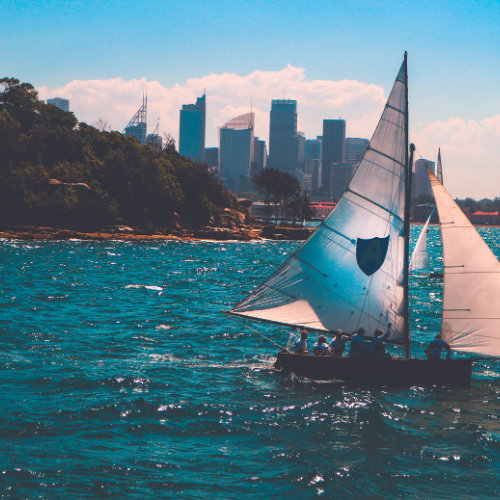
Port Jackson
Port Jackson is found within the waters of Sydney Harbour, and where better to explore Sydney’s famed sights than from the harbour itself. These sailing trips venture around the harbour and are a spectacular experience for both tourists and locals alike. Thanks to the warm, blissful weather paired with beautiful scenery, Port Jackson makes for one of the top sailing experiences in Australia.
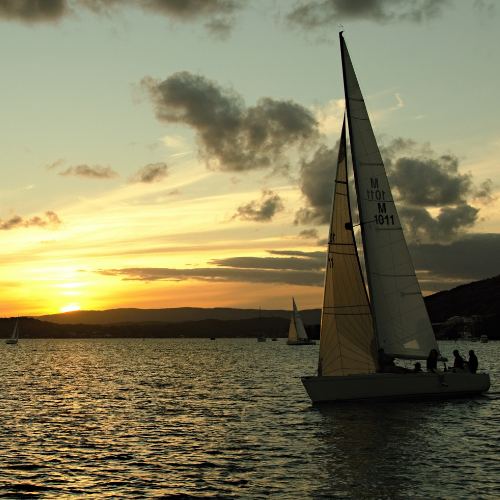
Lake Macquarie
Lake Macquarie is one of the top sailing destinations of New South Wales. Located just 150 kilometres north of Sydney, the lake connects with the Pacific Ocean on its east side. Lake Macquarie is pooled with sandy inlets and secluded bays perfect for sailing, swimming and snorkeling. Four times as big as Sydney Harbour and extremely quiet, Lake Macquarie is a perfect sailing destination in Australia.
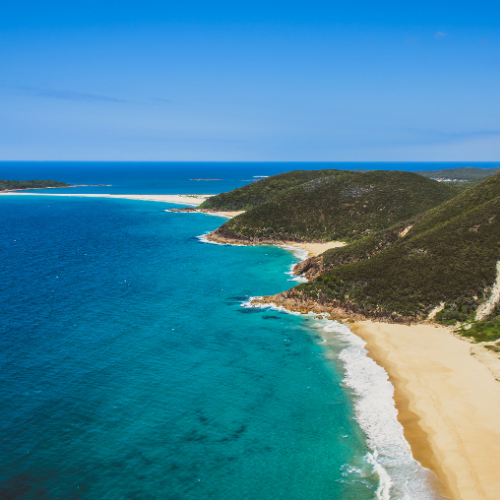
Port Stephens
The sparkling blue bay of Port Stephens is a brilliant place to sail. Named “The Blue Water Paradise” for obvious reasons, the bay is located tw0-and-a-half hours north of Sydney. The bay has over 30 kilometres of clean, white, sandy beaches and is home to whales and dolphins. Sailing in Port Stephens is a brilliant experience, and a fantastic holiday destination this sailing season. There is a sailing experience for all tastes in Port Stephens, so be sure to make the trip and enjoy this marine experience.
The Best Places to Sail in Victoria:
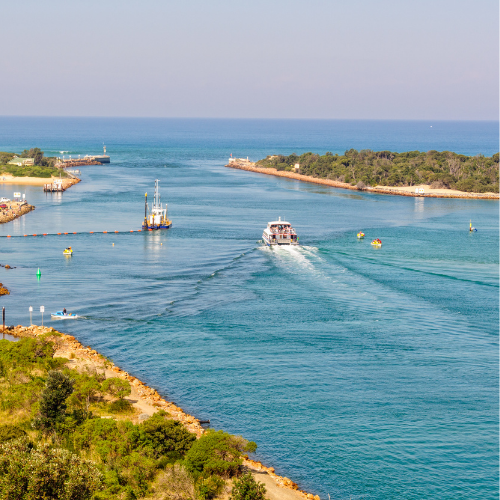
Gippsland Lakes
Under a four hour drive from Melbourne’s CBD or just over two hours from the heart of Gippsland lies one of Victoria’s largest and renowned network of Gippsland Lakes. Covering an area that stretches out to 354 kilometres, Gippsland Lakes is conveniently comprised of Lake Wellington, Lake King and Lake Victoria. Taking the title as one of the best places to sail in Victoria, sailing enthusiasts will feel anchored thanks to Gippsland Lakes’ circumference of marshes, lagoons and more.
The Best Places to Sail in Tasmania:
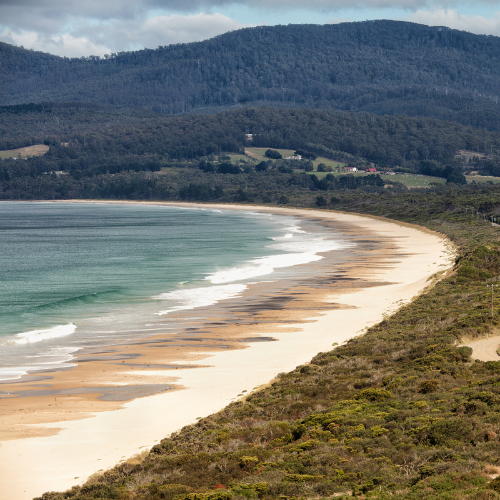
D'entrecasteaux Channel
Located between mainland Tasmania and Bruny Island – a two hour sail from Hobart and home to miles of sheltered water – D’entrecasteaux Channel is our top pick of Australia’s top sailing destinations. The channel is filled to the brim with secluded beaches and there are often dolphin, whale and seal sightings in the area. On specific tours you can learn how to sail and immerse yourself in all things sailing as you take the helm. If you’re looking to experience sailing and take in the beautiful blue waters of Tasmania, be sure to visit the D’entrecasteaux Channel.
The Best Places to Sail in South Australia:
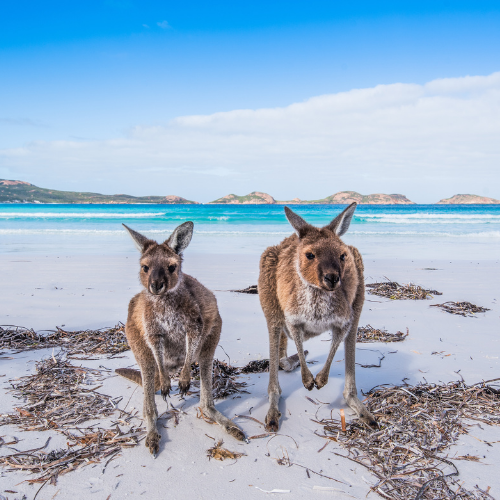
Kangaroo Island
Reachable by ferry, if you love to sail, then why not get the catamaran started and head off to one of South Australia’s favourite sailing destinations in Australia? Although it may be small in size, Kangaroo Island is mighty in all that it offers for cruising and sailing enthusiasts alike. With the island renowned for its protected nature reserves, on your next sailing adventure you and your crew could come up close and personal to native wildlife species and some of the most striking coastal rock formations.
The Best Places to Sail in Western Australia:
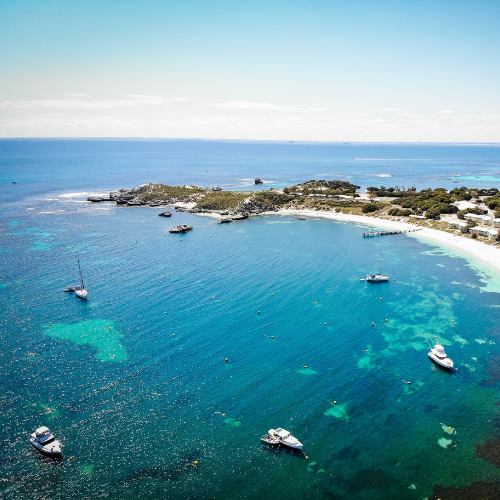
Rottnest Island
Located 19 kilometres off the coast of Fremantle, Rottnest Island is Western Australia’s very own island getaway. The island is Australia’s premier boating destination. You can catch a ferry to the island, but why not sail to the island in luxury instead? Sail to and around the island on a luxury catamaran and enjoy snorkeling, as well as plenty of other activities around the island. This is an incredible experience, so if you ever find yourself around Western Australia, be sure to put time aside to sail to Rottnest Island.
The Best Places to Sail in Queensland
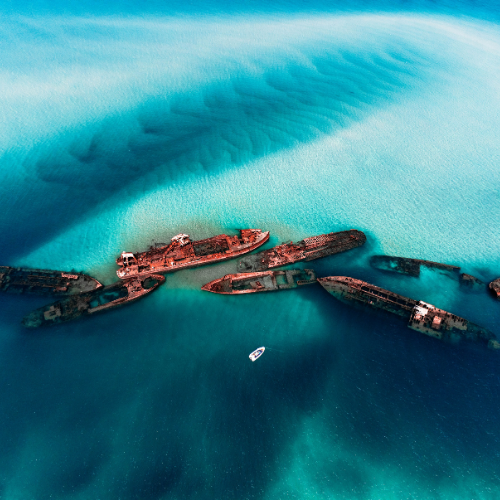
Moreton Bay
Moreton Bay is a gorgeous sailing destination on Queensland’s southern coast near Brisbane. Found between mainland Australia, Moreton and Stradbroke Island, the area is the ideal destination for water activities and has become a hub for boating, diving and swimming enthusiasts. Making for one of the best sailing holidays in Australia, here you’ll be able to stop at a variety of destinations including both islands and the Tangalooma Wrecks.
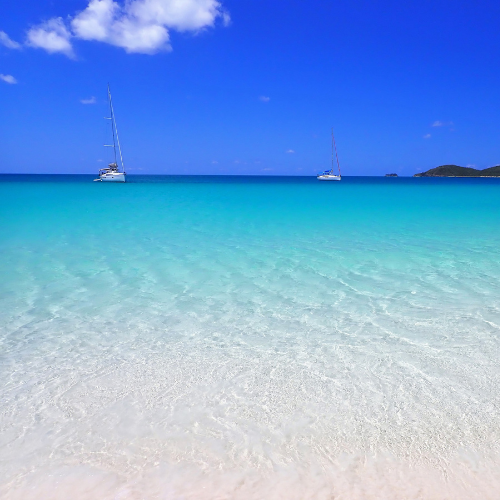
The Whitsundays
Meet the gorgeous Whitsundays, one of Australia’s classic summer holiday destinations. The islands around The Great Barrier Reef in Queensland are the perfect holiday destination, and you’re bound to have heard someone rave about how great Hamilton Island is! One of the best ways to explore this gorgeous part of Australia is on a boat, and sailing trips are a hugely popular attraction. There’s an array of sailing options to choose from: whether you want just a day on the water, or to stay several nights on a boat, there is surely a sailing holiday for you.
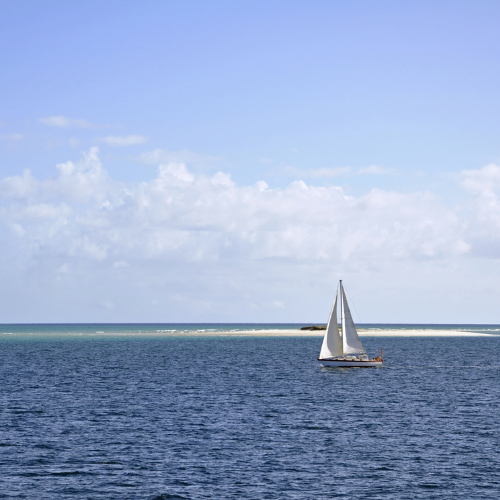
Great Sandy Strait
The Great Sandy Strait, located in between the Sunshine Coast and Bundaberg – between the mainland and Fraser Island – is a gorgeous and picturesque area, perfect for sailing. The water is incredibly clear, much like the Whitsundays, and makes for one of the most perfect places to get out on a yacht and relax for the day. The marine wildlife you can potentially come across in the Great Sandy Strait include whales, dugongs, dolphins and turtles, hence why the Strait is described as a marine sanctuary.
Love exploring the outdoors? Then get ready to dive into the 12 best snorkelling spots around Australia . And for some island-hopping inspiration, be sure to add these 10 beautiful islands around Australia to your 2021 bucket list .
We acknowledge the traditional owners of country throughout Australia and recognise their continuing connection to land, waters and culture. We pay our respects to their elders past, present and emerging.
Feature image: Photographed by Evan Smogor. Image via Unsplash.
This article was first published by tom sargeant on november 8 2018. it was updated and edited by hunter and bligh on february 18 2021..

Our goal is to guide a sophisticated market towards the best experiences the world has to offer. We'll offer you the latest in food and drink, tech, travel,entertainment and business by creating a guide specifically for you.
Copyright © 2023
- Prize Winners
- Prize Draw T&C
- Privacy Policy
- Collection Notice

Want great content delivered to your inbox and the chance to win $1,000?

- Yacht Sales
- Destinations
- Monaco Grand Prix
- About Ahoy Club
- Meet The Team
Yacht Season | Best Destinations For Yachting in September
September sees temperate weather in both the northern and southern hemispheres. In the north, the temperatures begin to lower as summer comes to an end, and things begin to warm up in the south. Arguably the place that offers the most this month is the Whitsundays on the Queensland coast in Australia. Average temperatures are in the mid 20s (celsius) during this time of the year, which is close to perfect!
In the northern hemisphere, both the East and West Mediterranean are in great shape in September, as is the New England region of the US, so there is no shortage of choice available!

Whitsundays
The average September temperature in the Whitsundays is 25.4 degrees (celcius), which means it’s perfect weather for a luxury yacht charter. Some of the most popular destinations in the Whitsundays include Hamilton Island, Neck Island, Whitehaven Beach, Hook Island, Bait Reef Lagoon, Butterfly Bay, Hayman Island and Stonehaven – each perfect for snorkelling, scuba diving, watersports, lazy beach days and reconnecting with nature.
Of course, no trip to the Witsundays would be complete without exploring the Great Barrier Reef, and early spring is considered one of the best times to experience it. The more cosmopolitan traveller will also be right at home experiencing the night life and cuisine of Hamilton Island, and the warm sun, white sand and crystal clear water at Whitehaven Beach will be beckoning for a September visit.
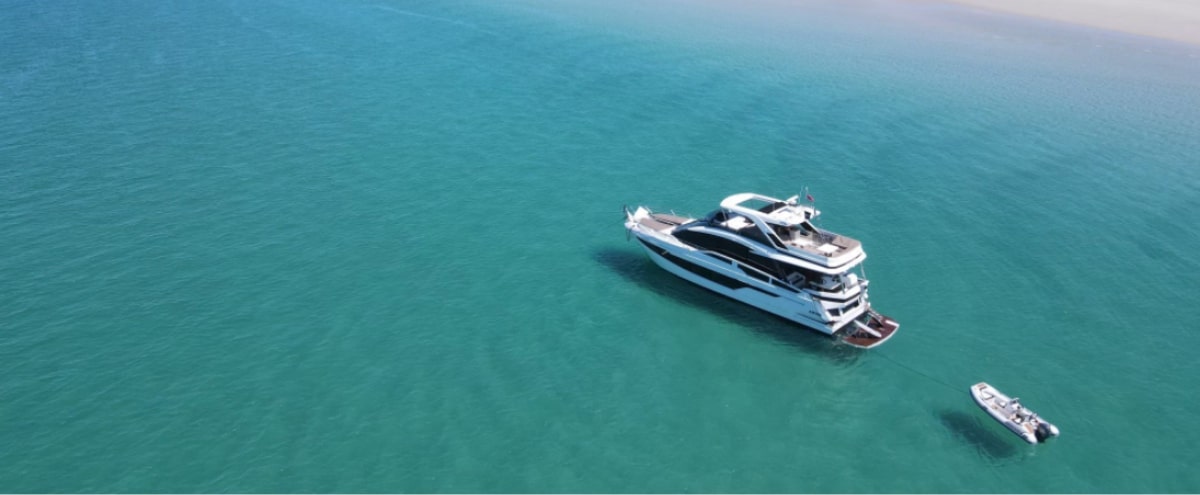
New England
Comprising the states of Connecticut, Maine, New Hampshire, Massachusetts, Rhode Island and Vermont, New England ’s famous Atlantic coastline is a paradise for luxury yacht charters wanting to take in the best that the region has to offer. Doing so in early autumn or fall will see average temperatures that are still in the 20s (celsius) during the day but can get down a fair bit lower at night, meaning the foliage of all of the region’s deciduous trees is beginning to become colourful which makes for a stunning view.
The New England coast has so much for you to explore, from the world’s historical whaling capital Nantucket, to the myriad of marine history that’s waiting for you to experience in Boston, a luxury yacht charter in this part of the world is made extra-special in September.

East Mediterranean
Just outside of the region’s peak season, September will see fewer tourists in this part of Europe, but you’ll still be experiencing temperatures in the mid to high 30s (celsius), which is just about as close to ideal as you can get.
The East Mediterranean holds its stature in being home to some of the most popular spots in Europe. The region has thousands of islands and charming coastal cities, making it a haven for yacht charters. Dotted with century-old bazaars and historic fishing ports, you’ll be spoiled for choice by the diversity of the places you will come across.
Get lost among the cobblestone streets of Dubrovnik Old Town or discover the untouched beauty of Albania’s Sarandë or the sun-soaked sands and pebble beaches of the Greeks Isles – the East Mediterranean is yours to explore in September.

West Mediterranean
In the West Mediterranean you’ll be spoiled with postcard-perfect islands dotting the sea and superyachts adorning almost every port. Unspoiled archipelagos can be found among some of the world’s most frequented beaches.
You’ll enjoy privileged access to some of the planet’s most prestigious destinations. From the azure island of Formentera who’s unforgettable magic is often overlooked for its more popular sister island, Ibizato Corsica’s sparkling Bonifacio, literally translating to “pretty face”; the options are endless. And of course, from the glitz of Cannes to the high-rollers of Monaco, a yacht charter around the French Riviera is one out of a film.

Where to Charter the Best Luxury Yachts in September
Make the most of the temperate weather in the Mediterranean, Australia and Eastern United States with Ahoy Club . Experience your dream yacht charter, with luxurious superyachts designed to take care of your every need in the world’s most popular yachting destinations. Ready to make your way to the hotspots on this list? Get in touch today or browse our charter yachts below to inspire your next adventure!
Make an Enquiry


WHERE CAN WE TAKE YOU?
Enquire now.
Thank you for contacting Ocean Alliance. We will reply to your enquiry as soon as possible.

- South Pacific
- East Mediterranean
- West Mediterranean
- Bahamas & Caribbean
- South East Asia
- North America
- Indian Ocean
- Central & South America
- Northern Europe
- Yacht Marketing
- Yacht Charter Management
- Yacht Commercial Structures
- Yacht Operational Support
- Yacht Fiscal Support
- Meet The Team
- Yachting for purpose

DESTINATIONS
Experience more

Recent Press & Blogs
Ocean Alliance Launches Charter Experience Hub
Ocean Alliance is proud to announce the launch of the Charter Experience Hub, an innovative and interactive platform designed to make the charter planning process more streamlined and enjoyable. Superyacht… Read More
The AIX Factor
With a name inspired by the vibrant city in southern France, AIX aspires to be the ultimate charter yacht. Unsurprisingly, as Mark Beretta observes on board in the Whitsundays, her… Read More
Best Luxury Charter Yachts Available in The Whitsundays
The Whitsundays yachting season is in full flow and there is a fantastic fleet of superyachts based in the region. Take advantage of a diverse selection of yachts to build… Read More
IMPULSIVE: Whitsundays Yacht Charter Icon
When looking to book a luxury superyacht charter in The Whitsundays, it is hard ignore the evergreen allure of IMPULSIVE. So, it’s a good thing that the yacht is offering… Read More
Join our newsletter to receive Ocean Alliance’s latest news & events.
Check out these awesome colours, captured by DE LISLE III’s @nigelwhy on charter in Fiji! DE LISLE III’s South Pacific charter season continues as she welcomed guests onboard in Fiji following a successful adventure in PNG. For any charter guest looking to experience the South Pacific by superyacht, DE LISLE III offers such a renowned platform backed up by an incredibly experienced and fun crew. “We hit the jackpot with the crew and yacht” - as ever, the feedback received from charterers has been exceptional and is a testament to the team onboard DL3. While receiving updates like this from @captaindanfarrell can make the office seem a little less appealing, it is great to see how much fun DE LISLE III’s guests (and crew!) are having. The 42m Gulf Craft yacht is welcoming charter enquiries for Fiji and Australia’s Great Barrier Reef. — 📱Looking to purchase, sell or charter a superyacht? Reach out to the Ocean Alliance team on [email protected] or +61(0)405767869 and tap into a wealth of yachting experience.

Launched! 🚀 We are delighted to have launched our new bespoke charter planning platform - The Charter Experience Hub. 🧑💻 Developed by our in-house team with collaboration from captains and clients, the Charter Experience Hub is a fresh and fun tool to help design your perfect charter. 📋️ With real-time information to ensure you never miss an update, the platform provides a visual and interactive way to engage with planning your superyacht experience. A far cry from back-and-forth emails! 📽️ A bespoke video series has been created to feature throughout the platform. In this series, a range of yachting experts provide insights into how to get the most out of your charter experience. The platform is ultimately centered around you, the charterer. The Charter Experience Hub is designed to enhance the personalisation of your superyacht adventure, ensuring that everything is prepared to perfection. 💫 That is the beauty of superyacht charter - the opportunity to make each and every experience entirely unique. We are delighted to have already received such fantastic feedback from both captains and charter guests who have used the Charter Experience Hub, and look forward to introducing more of our clients to this game-changing platform. -- 📱Looking to purchase, sell or charter a superyacht? Reach out to the Ocean Alliance team on [email protected] or +61(0)405767869 and tap into a wealth of yachting experience.
The ultimate yachting ❌️perience Project X is one of the most awe-inspiring superyacht available for charter 🤩 📍Currently available for charter in the Mediterranean hotspots of Sardinia and Greece, Project X`s rates start from €1,200,000 per week! The custom 88m superyacht really does deserve the title of `floating palace`, offering a staggering array of luxury amenities and incredible design throughout. These features include an award-winning beach club and spa, a lounge with fold-down balconies to water level, a triple-height glass atrium and lift (the largest on a yacht), an opulent main saloon with self-playing piano, a glass-edged swimming pool and outdoor cinema setup. If that`s not enough, charter guests can make the most of a stacked arsenal of water toys from top of the range jet skis to Fliteboards and SeaBobs. Project X Highlights: 📏 88.01m 👷 Golden Yachts 🧑🏻🎨 Ken Freivokh & Massari Design 🛏️ 9 Cabins 👥 12 Guests 🤵 28 Crew 🚤 Tenders: 12.48m Tender Vandutch – 10 seats , 9m Pedrazzini Vivale classic boat – 6 seats, 2 x 6.25m Whitmarsh sport ribs – 8 seats 🪂 Toys Highlights: 2 x seadoo GTX limited 300, 2x seadoo wake pro 230, 3 x Seabobs, 1 x Flite boards / E-foils, 2 x sea kayaks, 2 x transparent 2-person kayaks, 2 x inflatable paddle boards, Wake board, Waterslide, Water skis, Towing toys, Diving Equipment, Fishing Equipmen, Bikes, Full beach set up, Jelly Fish net pool -- 📱Looking to purchase, sell or charter a superyacht? Reach out to the Ocean Alliance team on [email protected] or +61(0)405767869 and tap into a wealth of yachting experience.
Step aboard LANCE 🛥️ The exquisite Sanlorenzo superyacht LANCE was captured on a new videoshoot on the iconic Sydney Harbour. 📍 LANCE is available for charter in The Whitsundays from September 2024, an opportunity to experience the ultimate yachting adventure. One of the newest and most luxurious charter yachts in Australia, LANCE brings ‘Made in Italy’ pedigree from the renowned Sanlorenzo shipyard. The 37.95m superyacht provides a perfect platform for entertainment on the water, with a contemporary interior and wide range of deck spaces to relax under the sun. The Sun Deck is one of LANCE’s highlights, featuring a wet bar and large jacuzzi. LANCE sleeps up to 10 guests across 5 opulent suites, including a full-beam Master with his-and-hers ensuite. — 📱Looking to purchase, sell or charter a superyacht? Reach out to the Ocean Alliance team on [email protected] or +61(0)405767869 and tap into a wealth of yachting experience.
🔎 Head of Charter Ocean Alliance is searching for a dynamic, client-focused professional to join our team as Head of Charter. This exciting role will oversee charter management and retail, while maintaining the strong DNA and reputation of the company’s charter division. Please contact Managing Director Joachim Howard for further details. [email protected].
One of Europe`s best charter spots 💫 From the breathtaking cliffs of Taormina to the historic shores of Palermo, Sicily offers an unforgettable blend of culture, cuisine, and cerulean seas. 🛥️🍷 Experience Italy like never before—book a superyacht charter to explore Sicily’s hidden coves and vibrant local life in the ultimate luxury and exclusivity. 📸 What`s your dream Sicilian destination? Comment below with a friend you`d take here! #Sicily #yachtlife #superyacht #luxury #travel #Italy -- 📱Looking to purchase, sell or charter a superyacht? Reach out to the Ocean Alliance team on [email protected] or +61(0)405767869 and tap into a wealth of yachting experience.
Whitsundays & watertoys 💯 Hard to think of a better place to put your watertoys to the test than in the stunning Whitsunday Islands! IMPULSIVE has Australia`s largest watersports inventory, perfect for adding endless thrills to your superyacht charter. Among IMPULSIVE`s stacked arsenal are 2 Flite Scooters, a 2023 GTX 300 Seadoo Jetski and Jet Boots. IMPULSIVE also carries an exciting array of FunAir equipment, from an inflatable waterslide to a customised Sea Pool and Beach Club. For reaching those more remote islands, beaches and reefs, IMPULSIVE is accompanied by a brand new SACS Strider 11 Open Back tender, seating 10 guests. -- 📱Looking to purchase, sell or charter a superyacht? Reach out to the Ocean Alliance team on [email protected] or +61(0)405767869 and tap into a wealth of yachting experience.
A new home for superyachts in the Maldives 🔜🏗️ The Maldives is getting its first dedicated superyacht marina, pointing to an exciting future for charter in this Indian Ocean gem. The Maldives has long been revered as a luxury destination, and is certainly no stranger to large visiting superyachts with the likes of 85m BOLD regularly available in the region. However, superyacht-specific facilities will greatly increase the capacity to host superyachts, as well as enhancing the surrounding lifestyle. That is exactly what is promised by the Zamani Islands development in the South Malé Atoll. Zamani Islands will be a lifestyle destination that includes the country`s first superyacht marina and yacht club. Renowned studio @yodezeen_architects is responsible for the design and architecture of the Zamani Island project, lending its wealth of experience in ultra-luxury private residences. The resort development spans across eight islands and extends 5,000 metres into a natural lagoon. The superyacht marina will cover 60,000 square metres and will offer docking services as well as a state-of-the-art yacht club. The Zamani Islands resort and marina is a major boost to the accessibility of this stunning region by superyacht. The development will launch its first phase in Spring 2026. -- 📱Looking to purchase, sell or charter a superyacht? Reach out to the Ocean Alliance team on [email protected] or +61(0)405767869 and tap into a wealth of yachting experience.
Want to charter like a President? For the first time ever, the former Presidential yacht used by 5 Presidents including JFK and Eisenhower has become available for charter. We often talk about superyacht charter being a gateway to unique experiences, and it doesn`t get quite as special as stepping onboard this piece of history. HONEY FITZ was first delivered in 1931 by Defoe Boat & Motor Works. As she became the Presidential yacht, she was frequently used in particular by John F. Kennedy, and Jacqueline Kennedy was involved in her interior redesign in the early 1960s. More recently, HONEY FITZ completed a complete restoration in 2020 to give a new lease of life to this legendary yacht. The environment onboard the yacht retains the heritage and authenticity of this yacht, with many features dating back to the original build in 1931 and throughout the yacht`s presidential eras from 1945 to 1971. 📍HONEY FITZ is based at the Pelican Club in Jupiter, Florida, offering private charters and events for up to 35 guests. -- #superyacht #charter #president #usa #florida -- 📱Looking to purchase, sell or charter a superyacht? Reach out to the Ocean Alliance team on [email protected] or +61(0)405767869 and tap into a wealth of yachting experience.
See the world, all of it 🌎️ Check out this video from the renowned explorer yacht LEGEND in Svalbrad, Norway. 🎟️ Yachts are an unlimited ticket to exploring the world’s oceans. While we work with many yacht charters to curate itineraries in the familiar yachting hotspots, we also look forward to developing experiences in more remote and unchartered territories. There should be no limits when planning your suiperyacht charter. Unless you’re planning on exploring a desert, we can help find the perfect yacht for your group in any destination. LEGEND, built by Icon Yachts, is ideally suited to the wanderlust explorer. She boasts all the features required for Arctic and off the beaten track adventures, from submersibles to heli operations and jet skis. 📍 LEGEND will be in the Med for the rest of Summer, before relocating to offer charters in Patagonia and Antarctica over Winter. 📹 @legendexplorer — 📱Looking to purchase, sell or charter a superyacht? Reach out to the Ocean Alliance team on [email protected] or +61(0)405767869 and tap into a wealth of yachting experience.
Fly into a big Euro summer, superyacht style 😎 There are plenty of incredible offers available on last minute superyacht charters in the Mediterranean. Contact the Ocean Alliance Charter Team on [email protected] to find the perfect charter opportunity for you and start building your dream itinerary. 📍St George Bay, Symi, Greece 📹️ Shot by our friend the incredibly talented & adventurous @iamfabreezy — 📱Looking to purchase, sell or charter a superyacht? Reach out to the Ocean Alliance team on [email protected] or +61(0)405767869 and tap into a wealth of yachting experience.
✅️ Secured We are delighted to have placed a valued charter client onboard the iconic 61m superyacht ARIENCE. Built by German shipyard Abeking & Rasmussen in 2012, ARIENCE is a unique opportunity in this category on the charter market. She boasts incredible volume which translates into vast social spaces equivalent to a much larger superyacht - perfect for making the most of your time on the water. ARIENCE is stacked with incredible amenities to make sure your charter is filled with plenty of activity, including a 55ft wajer tender, waterside gym, beach club, and lower deck cinema. She accommodates up to 12 guests across 7 staterooms, with a fantastic crew of 16 onboard dedicated to helping you live the best experience. ARIENCE is based in the Mediterranean until October when she will relocate for the Caribbean season. Charter rates for ARIENCE start from €595,000 per week. -- 📱Looking to purchase, sell or charter a superyacht? Reach out to the Ocean Alliance team on [email protected] or +61(0)405767869 and tap into a wealth of yachting experience.


The global authority in superyachting
- NEWSLETTERS
- Yachts Home
- The Superyacht Directory
- Yacht Reports
- Brokerage News
- The largest yachts in the world
- The Register
- Yacht Advice
- Yacht Design
- 12m to 24m yachts
- Monaco Yacht Show
- Builder Directory
- Designer Directory
- Interior Design Directory
- Naval Architect Directory
- Yachts for sale home
- Motor yachts
- Sailing yachts
- Explorer yachts
- Classic yachts
- Sale Broker Directory
- Charter Home
- Yachts for Charter
- Charter Destinations
- Charter Broker Directory
- Destinations Home
- Mediterranean
- South Pacific
- Rest of the World
- Boat Life Home
- Owners' Experiences
- Conservation and Philanthropy
- Interiors Suppliers
- Owners' Club
- Captains' Club
- BOAT Showcase
- Boat Presents
- Events Home
- World Superyacht Awards
- Superyacht Design Festival
- Design and Innovation Awards
- Young Designer of the Year Award
- Artistry and Craft Awards
- Explorer Yachts Summit
- Ocean Talks
- The Ocean Awards
- BOAT Connect
- Between the bays
- Golf Invitational
- BOATPro Home
- Superyacht Insight
- Global Order Book
- Premium Content
- Product Features
- Testimonials
- Pricing Plan
- Tenders & Equipment

Australia luxury yacht charter
Boasting the world's greatest natural reef plus dazzling waterfront cities, rainforest framed beaches and tropical waters, the many sides of Australia provide unparalleled cruising possibilities in Oceania. With such vast and diverse cruising grounds, a luxury yacht charter in Australia has something for everyone. Mix bright lights and iconic sights in Sydney with golden beaches, discover final-frontier beauty in the Kimberley, dive into the natural wonders of the Great Barrier Reef or swoon over shifting sands and shallows of the Whitsunday Islands.
Australia yacht season and weather
Located in the Southern Hemisphere, Australia offers warmer temperatures and sunnier days during what would be the cold winter season in higher latitudes.
The Great Barrier Reef and The Whitsundays offer ideal sailing conditions during Australia's winter months, from April to November before the wet season begins from December to March. Temperature highs during this time range from 25 to 30°C. The city of Sydney and surrounding coastlines meanwhile are best visited during the dry season which occurs between the months of November to late January, with temperature highs ranging from 23 to 26°C.
Australia yacht charter itineraries
The majority of Australia charters are taken around the Great Barrier Reef and the Whitsundays where there are many sheltered anchorages for overnighting.
Cairns is a popular jumping off point for Great Barrier Reef charters and Cairns Marlin Marina accommodates yachts up to 140 metres. Crystalbrook Superyacht Marina in Port Douglas has 135 berths that can accommodate yachts up to 50 metres.
For the Whitsundays, Coral Sea Marina near Airlie Beach accommodates yachts up to 80 metres and Hamilton Island Marina has slips for yachts up to 45 metres.
The Great Barrier Reef is the world’s largest coral reef system, comprising more than 3,000 reef chains, coral cays and picturesque islands. Charters are characterised by short hops and a dizzying array of picturesque stops. Set sail from Cairns to the Ribbon Reefs, where tropical fish abound. Scuba dive at Ribbon Reef No.5, nicknamed Andy’s Postcard, and anchor overnight under a jaw-dropping blanket of stars before revelling in more sublime snorkelling and underwater magic at Pixie’s Pinnacle and Cold Hole. Next up, cruise to the bewilderingly beautiful beaches of Lizard Island and the aptly named Blue Lagoon. Around 45 nautical miles south of Lizard Island, sample a little Australian history at Cooktown – the site of Captain Cook’s landing. Your skipper can then cherry pick the best snorkelling spots en route to an idyllic picnic on a private and secluded sandy cay before heading south to the fine dining and five-star spas of exclusive Port Douglas, 30 nautical miles north of your home port of Cairns.
Another exceptional charter ground brimming with easy passages and sublime cruising is the Whitsunday Islands . This spellbinding archipelago boasts more than 70 isles with show-stopping snorkelling and diving, exceptional corals and a dusting of exclusive resorts. Charters often depart from Hamilton Island, where picturesque beaches abound. Cruise 10 nautical miles to the snorkelling paradise of Neck Bay and spend a tranquil night on anchor before making passage to Long Island Sound and the protected waters of Cid Island. Kayak along the mangroves and watch the sun melt into the horizon at Katoomba Bank. Along the west coast of Whitsunday Island, unleash the water toys – this is one of the few areas where jet skis are authorised. Hook Island (10 nautical miles north) offers more incredible diving and snorkeling, with reef fish, turtles, dolphins and manta rays often spotted in the Whitsunday Passage. Don’t miss the Outer Reef, where the dramatic drop-offs are home to turtles, reef sharks and barracuda. Finally, cruise south to the iconic sweeping sands of Whitehaven Beach.
While the Whitsundays and the Great Barrier Reef are justifiably popular for charters, Australia’s other coastlines offer equally exciting cruising options depending on your interests. Sydney Harbour boasts iconic sights, exceptional waterside dining and ample coves. Hermit Bay, the western shore of Shark Island and Athol Bay offer some of the best sunset views overlooking the Sydney skyline. Short coastal hops bring you to the Hawkesbury River, perfect for exploring by tender.
Alternatively, opt for a final frontier explorer adventure and cruise along the wild and awe-inspiring north-west coastline. The Kimberley is three times the size of England and punctuated by plunging gorges, swirling rivers, rainforested lagoons, and more than 2,500 uninhabited islands. There’s enough to keep you busy here for days, weeks or even months, and it’s a true nature lover’s paradise.
Australia by superyacht
Getting to australia.
The main airports in Sydney, Brisbane and Cairns all handle commercial and private aircraft.
For Kimberley, fly direct to Broome from Perth all year round.
In the Whitsundays, Hamilton Island has a small airport, which handles commercial and private aircraft.
Legal requirements
Unless you are an Australian or New Zealand citizen, all travellers to the country will need a Visa. The issuing of a Control Permit is required to cruise Australian waters.
All vessels are required by law to notify the Australian border force prior to arrival and must clearly display the International Pratique Q-flag.
On arrival, yachts must go directly to a recognised port of entry and undergo a biosecurity check before guests or crew can step on shore. Australia has particularly strict rules regarding the importation of animals, foodstuffs and plants.
Foreign flagged vessels coming to Australia that wish to charter do not require importation under the 2019 Special Recreational Vessel Act. Taxation is only payable on the charter cost (10%), not the value of the vessel.
Yacht features
- BOAT OF THE YEAR
- Newsletters
- Sailboat Reviews
- Boating Safety
- Sails and Rigging
- Maintenance
- Sailing Totem
- Sailor & Galley
- Living Aboard
- Destinations
- Gear & Electronics
- Charter Resources
- Ultimate Boat Giveaway

Well, Hello, Old Friend: A Cruise Up Australia’s East Coast
- By Kevin Green
- April 19, 2022
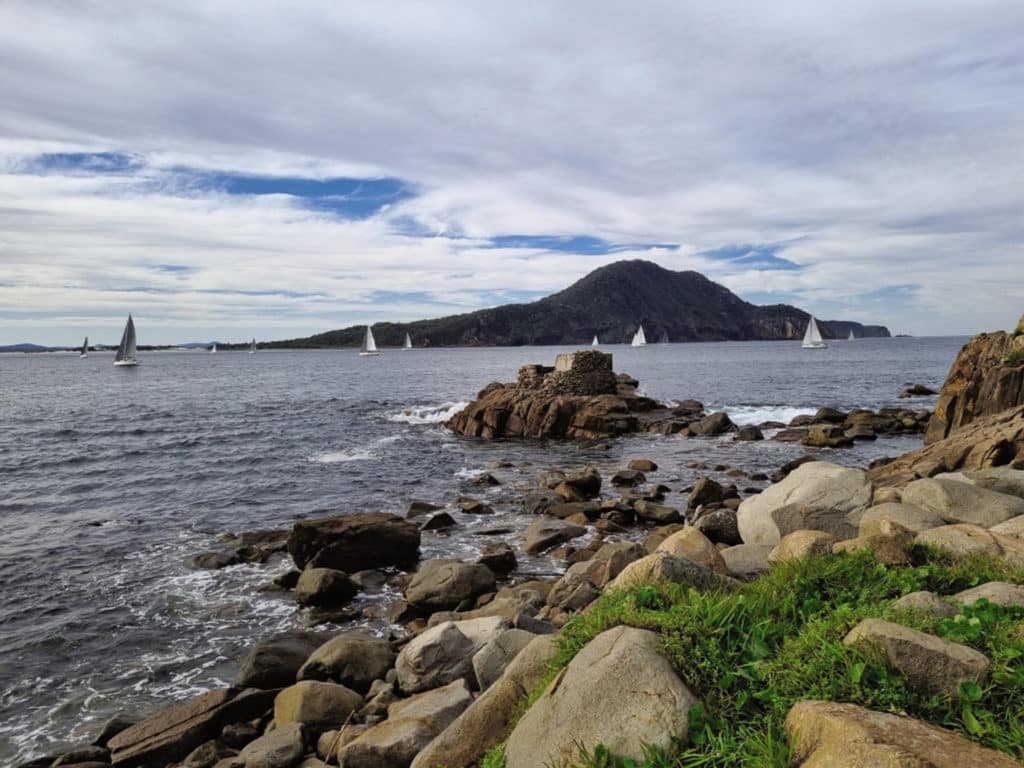
Our Contessa 25, Skyebird , lay at its mooring in Sydney Harbour, looking forlorn after my year trapped overseas amid the COVID-19 pandemic. Finally back in the Land of Oz, I rowed out to her, my mind filled with thoughts of sailing. It was January—midsummer in our Southern Hemisphere—and my wife, Carole, and I had just enough time to prepare for a voyage north to escape the Australian winter.
Skyebird is a former racer-cruiser that knew Australia’s waters well in its racing heyday. Australia’s east coast is the country’s most popular sailing area—and the most populated part—so there is access to services along the way. Stretching from the edge of the Southern Ocean to the Torres Strait, along an island larger than Europe, the cruising region is one that I have enjoyed several times. It’s best broken into two legs: Sydney to Brisbane, and then the tropical leg north to the Torres Strait and the Indian Ocean. The route is pristine cruising with relatively few other yachts.
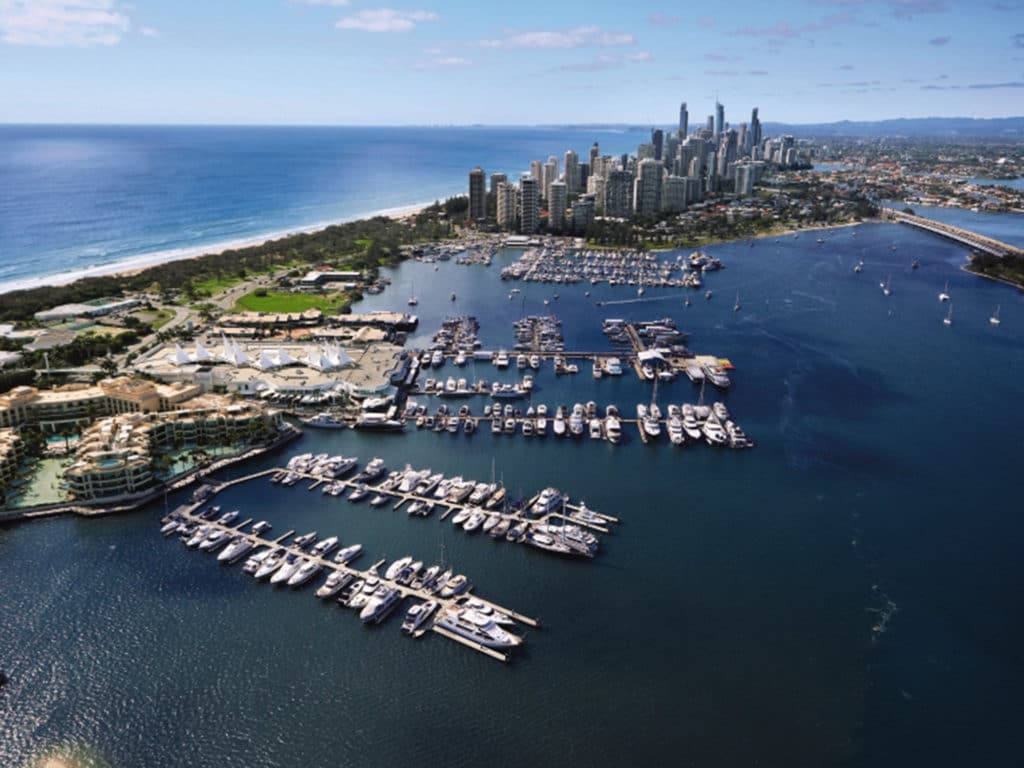
After several months of preparations, we set out in April to cruise the first leg. We gave ourselves six weeks to sail in daylight or overnight, according to the weather. The southern half of the region is more temperate, and the tropical northern part is in the hurricane zone from November to February. The storms can be powerful; Cyclone Debbie, which destroyed much of the Whitsunday Islands charter fleet in March 2017, had the force of a Category 3 hurricane.
Even after this destruction, the beauty remains. I think of the Whitsundays like the Caribbean in terms of weather, as well as quiet beaches, deep anchorages and, offshore, the beginning of the Great Barrier Reef’s sheltered cruising ground all the way to the Torres Strait.
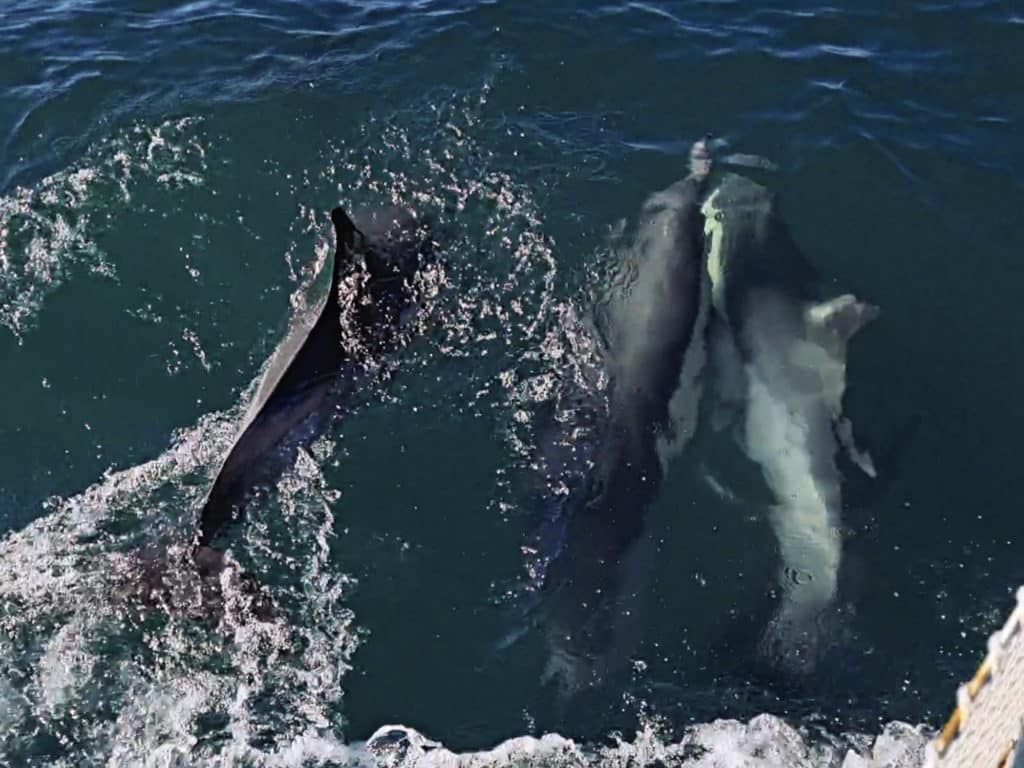
Settling into the cruise
Aboard Skyebird , the day had worn on and the wind had lightened, so I hanked on the genoa instead of the working jib for us to reach our destination of Broken Bay before nightfall. Motoring was not really an option because we had only an 8 hp outboard in the transom well. Broken Bay is the Sydney region’s main cruising ground—a network of estuaries, rivers and creeks that offer good shelter. As we sailed in, we passed the busy yachting area known as Pittwater, which is home to several yacht clubs and marinas.
We glided into our favorite anchorage as the sun fell below the western hills. Later, whisky in hand and our fleeces on, we sat on deck enjoying the evening song of the kookaburras’ laughter. With the strong Australian sun having charged our battery from the two solar panels, I used my laptop to check the weather for the next leg, a 50-nautical-mile sail to the major port of Newcastle.
Early the next morning, we hoisted sail before sunrise and glided seaward past the winking lighthouse at Barrenjoey Head. With safety in mind, I used my phone app to register our voyage with the Marine Safety Authority. At the tiller, Carole enjoyed the thrill of sailing Skyebird over the swells as the breeze filled in to about 15 knots and white spume flew from the wave crests.
Pilotage on Australia’s east coast is relatively benign at first glance: short tidal range, stable weather and lots of sunshine. But there are hazards, such as the strong, south-flowing East Australian Current. It’s a lee shore when strong easterlies blow, and many of the anchorages are guarded by shifting sandbars. Australian surfers are often world champions for a good reason.
The famous southerly wind caught up with us about 10 miles south of Newcastle and then backed easterly. On the foredeck, I wrestled down the genoa for the working jib as we sped along at 7 knots. Our inshore track was now dangerous, so we added some offing as the gusts grew to 25 and then 30 knots. A second reef was put into the mainsail. Slab reefing, gooseneck bullhorns and a topping lift had been my major changes to the rig, and they were all essentials on this voyage, along with using the heavy topping lift as a running backstay. Conditions worsened, so I worried about the east-facing entrance to Newcastle Harbour, a narrow gap known for cross seas. On approach, we followed an arriving coal boat and surfed in on the breaking swells as night fell over the town.
As we settled into our berth at the Newcastle Yacht Club, a neighbor congratulated us on having the smallest oceangoing vessel there, beating his home-built Vertue 26 by a mere 6 inches. The next day, he kindly drove me to Whitworths, which is Australia’s main chandlery chain, and then to Jaycar (kind of like RadioShack) for electrical components.
But we weren’t in civilization for long. A few days later, we headed north, sailing wing on wing along the seemingly endless beaches of the Stockton Bight. Light southerlies propelled us toward the towering headlands that marked the entrance to the next main cruising ground, Port Stephens. Larger than Sydney Harbour and with hidden estuaries and creeks, it attracts cruising and racing sailors. The main town, Nelson Bay, and the general region were once considered for Australia’s capital, but it’s a terribly shallow area where channels must be religiously followed, or sandbars and rocks await your keel.
Approaching the heads at Port Stephens can be done only in mild conditions, so we skirted the southern headland below the lighthouse, then studied our Raymarine echo sounder. The numbers fell 6 feet before we found a public mooring at Salamander Bay during low tide. These moorings are meant to be for 24-hour use, but a couple of days can usually be spent on them.
After rowing ashore, we celebrated our arrival in port from the balcony of the Game Fish Club with some gamefish on our plates, no doubt courtesy of the high-end angling boats that hunt the black marlin in the area.
A relaxing stretch
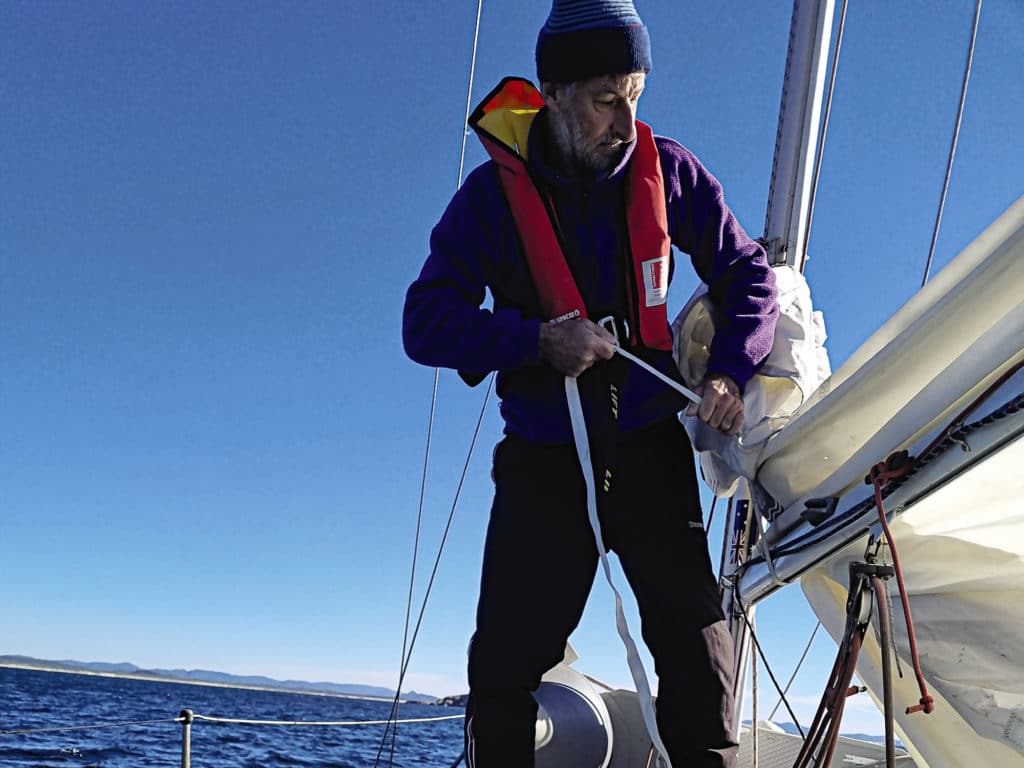
The next day, a swim at the beach roused us just in time to watch the racing fleet pass. The four main marinas were packed for the annual Sail Port Stephens event. A grand-prix division of TP52s scythed past our boat, and I considered joining one as crew. My wife read my thoughts and reminded me that I was in cruise mode for this trip, so I ignominiously went grocery shopping instead.
Our next destination was only a 15-mile sail yet one of the most sublime, into the Broughton Archipelago. Guarded on all sides by shoals, some uncharted, its fortress-type exterior deters most yachties, but I knew it well. As we came under the lee of its north side, the water revealed myriad browns (shoals), sky blue (sand) and deep blue (clear water). A shark swam by—the region is a gray shark nursery—as a muttonbird swooped in toward its burrow. Then, sheer bliss as the engine stopped, its sound replaced by the piping of sooty oystercatchers and the quizzical look of cormorants drying their wings on a nearby rock.
The Broughton Archipelago is a national park, but it used to be a fishing settlement. The Gumbaynggirr and other aboriginal tribes would have paddled the 2-mile mainland crossing when the surf was low. The mainland itself has towering gum and eucalyptus trees (the largest one in the entire state of New South Wales is nearby). The place is beautiful today, although its history is bloody; it’s the site of one of the worst aboriginal massacres in this bloodstained land. The Fatal Shore by Robert Hughes is essential reading for those interested in the formation of white Australia.
On Skyebird , the sweet scent from our methylated stove told me that Carole was preparing dinner while I landed a few zebrafish with the rod. After a run ashore, we knew that lingering at Broughton with a usable southerly was not wise, so the following day, we threaded through the reefs with a pod of 100 dolphins escorting us. “Look, a double-finned one!” Carole shouted, pointing toward one that turned out to be a large, gray nurse shark checking out our trailing lure—which I quickly retrieved.
A few challenges
Just as well, because we were approaching one of the major headlands, Sugar Loaf Point. It’s strewn with shoals where sudden swells break. We could see them ahead, but I could see a few more were hidden from eyesight when I zoomed in on my Navionics smartphone chart and checked the Blue Charts on my Garmin plotter.
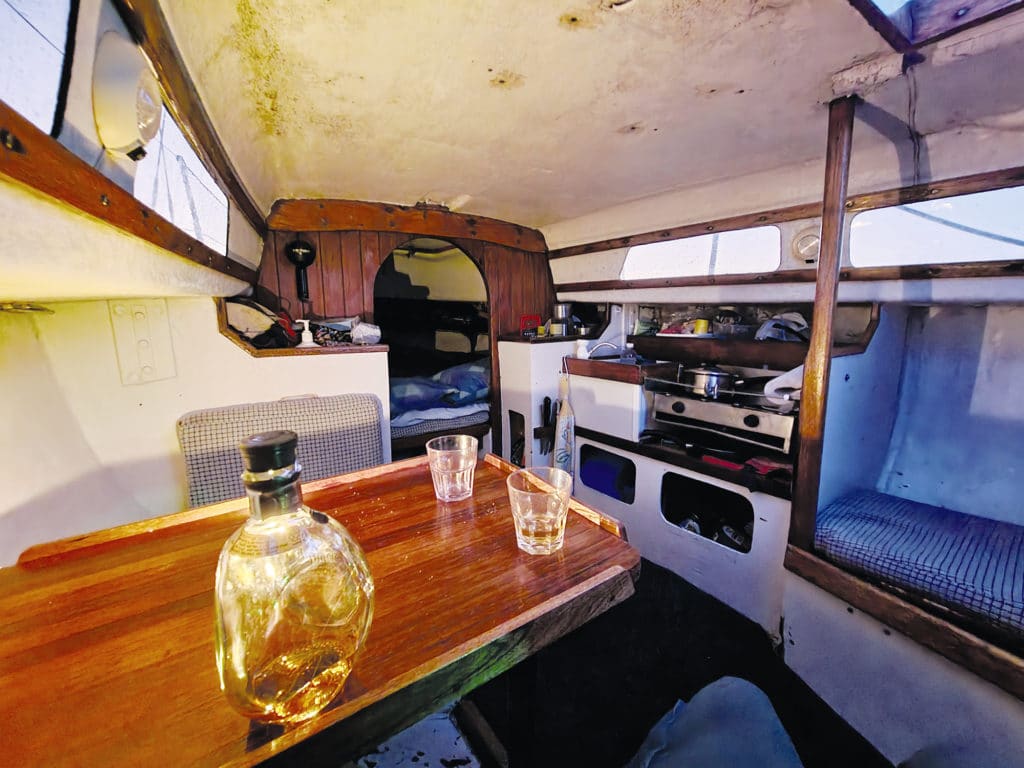
Even knowing the area well, we were shocked as a huge swell reared up right beside us, just as a shoal, or bommie, revealed itself. Chastened, we carefully sailed beyond the lighthouse. Just like when I’ve raced this coast, we kept in low to avoid the 3-knot current, but it’s a dangerous game to rock-hop. Ahead, Skeleton Rocks bared its teeth at us in passing, just as the afternoon wind died. Avoiding drifting nearer required using the Mercury outboard, so with a plume of two-stroke smoke, we plodded along. The sun bit down on us, and we grew disgruntled, chomping on egg sandwiches while I thought of a plan.
Motoring was not a long-term option on Skyebird , so I reluctantly resolved to put in at the river entrance of Forster, yet another sandbarred hamlet. However, with no easterly swell, that bar was quiet as we motored over it against the strong outflowing tide, dodging prawn trawlers as we went. The channel of only 50 meters wide in parts held our attention, as did the mere 1 meter under our keel.
Finally, we lassoed a piling and came to a semigracious halt near the fishermen’s cooperative. Later, my worry about depth proved correct as I watched the full moon semidry us out, causing me to leap off and secure the mast to a nearby power pole. Our slightly drooping bow revealed the one major flaw in the Contessa 25 design: a cutaway angled forefoot on the keel, unlike the flat forefoot of the English Contessa 26 that regularly takes the ground in the tidal UK.
The next day, the town’s plentiful facilities—including Woolworths, a gas station, and a club where I enjoyed a draft VB, the most typical of Aussie beers—were easily within walking distance.
Leaving Forster with only a light southerly felt like déjà vu , so again, we had to consider shortening our sea time. Like all diligent sailors, I did have a secondary port in mind—in fact, the only one: the commercial fishing harbor at Crowdy Head.
This headland, like many Anglo-Saxon ones, was named by Capt. James Cook when he surveyed this coast in 1770. Drifting windless would only mean the current sending us southward, so we carefully glided into the shallow harbor with only inches below our keel, right alongside the jetty.
Later, I threw out our smaller, second anchor to work as side rope—an old technique from my commercial-fishing days in Scotland, where 30-foot tides required creative mooring. The view of the Three Brothers mountains to the north was enjoyed with a Dimple whisky. My son and I regularly surfed the beaches around here, using the farm of a family friend. Famously, Australian novelist Kylie Tennant had a writing hut here and fondly wrote about some of that farming family in her book The Man on the Headland .
The next day saw us running north for our first overnight part of the trip, something that Carole was apprehensive about. With no ports of refuge on this leg, my weather planning had been done carefully, but it didn’t prevent strong winds and sail changes under the tall Smoky Cape. We were glad to see the lights of the all-weather port and town of Coffs Harbour and its good marina. It’s about the cheapest on the coast, and we stayed for 10 days, enjoying the restaurants and our walks up Muttonbird Island to view the nesting shearwaters.
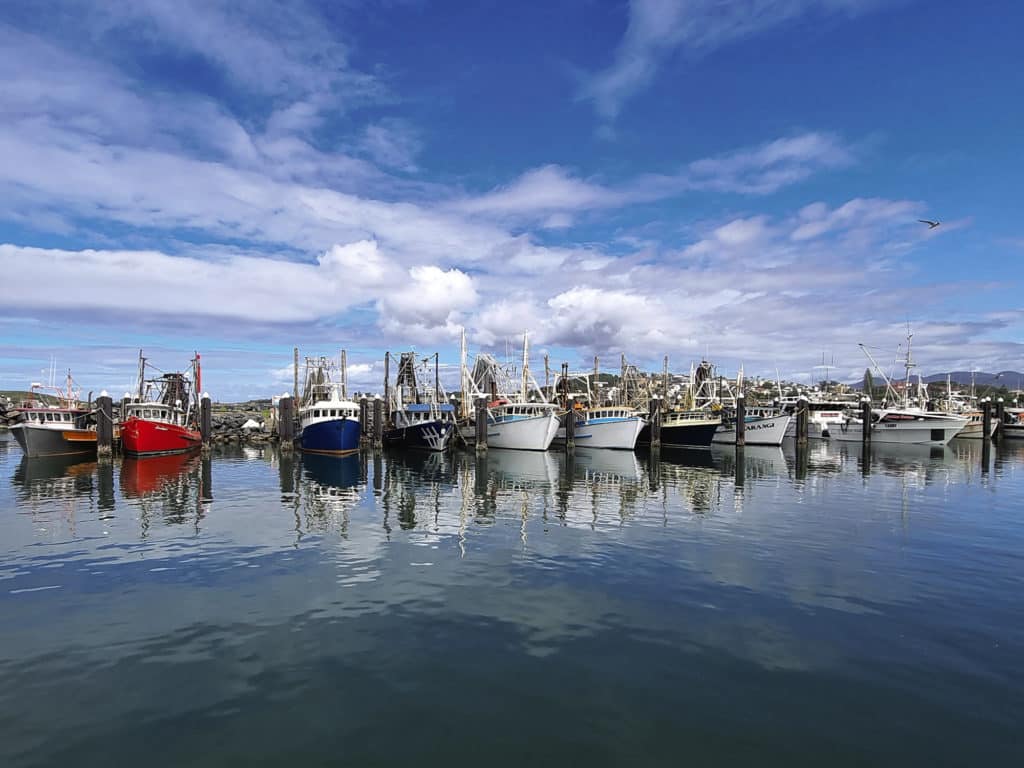
A rough end to the journey
With the planned departure of my lovely wife, the next 200-mile leg was done alone. It began in big swells and wind as I caught the end of a gale to propel me northward before the forecasted lull. However, conditions were heavy and broke the Raymarine Tiller Pilot linkage. As I surfed down 12-foot swells with only the mainsail up, I considered my options.
There was only one that seemed worthy: North Solitary Island, where I’d heard about fishermen sheltering. With night falling, I closed its wild coast and then sharply turned east into a tiny cove on its northern end. This rocky perch in deep water afforded me enough shelter to rebuild the shattered wooden linkage, and allowed some fitful rest before the long leg that would take me to my final destination on the Gold Coast in the state of Queensland.
Contrary to the Bureau of Meteorology forecasts for the next day, conditions again worsened considerably as I passed the one possible shelter at the rivermouth town of Yamba, with its breaking sandbar entrance. More sail changes ensued, and then the ship traffic began. I’d been monitoring the ships via my Marine Traffic phone app with a good 4G signal, but there is a delay in this system. And, of course, an app is no substitute for proper shipboard AIS. So I found myself dodging coal ships and some unidentified vessels, including one that I thought was a barge tow, causing me real anxiety.
Then the gale hit just as my autopilot batteries expired. Thankfully, I had prepared for this potential problem by catnapping in preparation for helm time.
The worst of the gale came 20 miles off Australia’s most easterly point, Cape Byron, an often-feared place with the strongest of the East Australian Current. I trimmed the jib enough to allow Skyebird to self-steer with the helm lashed. Gaining some respite below from the rain and wind, I recovered, but I knew that the current had gotten me. I battled to douse the main, and with no autopilot, I tacked toward the powerful Cape Byron Lighthouse beam and, at last, beyond the river towns of Nambucca Heads and Tweed Heads, and the final obstacle, the shoals on the south end of the Gold Coast.
With daylight, the towering skyscrapers of this Las Vegas-by-the-sea welcomed me shoreward and provided some blessed relief from King Neptune’s realm.
Kevin Green is a sailor and yachting journalist based in Sydney.
The C ontessa 25
A quarter-tonner penned by Australian America’s Cup designer Peter Cole, the Contessa 25 has sweet sheerlines, a semilong and encapsulated lead keel, and a sizable skeg/rudder that, together with a 44.5 percent ballast ratio, makes it a stiff boat. There’s a fairly tall deck-stepped rig of about 36 feet with an inner forestay and a sail plan that has 120 percent genoa plus a symmetrical spinnaker. This boat’s class dominated the Sydney racing scene in the 1970s with 50 hulls launched. The hull is solid GRP that’s thickly laid, and all the bulkheads and cupboards are glassed. The mast has a 4-inch-thick wooden archway connected to the keel.
The design is, in a word, sturdy. In 1972, one Australian magazine declared after the sea trial that its team would take the Contessa 25 around the world. Race results made some sailors famous, such as aspiring boatbuilder Bruce Ritchie. Bruce Fairlie, at East Coast Yachts in Gosford, built the Contessa 25 as a scaled-down version of the Cole 43 that won Admiral’s Cups and Sydney-Hobart races, and completed record-breaking circumnavigations.
The deck was simply laid out with a tiller, self-draining cockpit, and large forehatch for spinnaker hoists. Inside, the Contessa was highly customized for each owner. Skyebird (most likely Hull No. 48) has a V-berth and quarter-berth, plus a third that is accessed by removing the table. It is an ideal cruising layout for my wife and me because there’s a large cockpit lazarette instead of a second quarter-berth.
The standard galley came with a two-burner Maxie stove—the same type I retrofitted to Skyebird —along with a sink. Sharing the V-berth on some hulls was the Bryden Boy head. A useful fitting was the removable jerry-can water tank, handy for Junior Offshore Group racing.
The standard inboard engine was a 5 hp gas-powered Albin with a feathering propeller. A diesel Volvo Penta MD1 could also be fitted.
- More: australia , Coastal Cruising , Destinations , print 2022 april
- More Destinations

Paradise Pummeled

A Guide to Cruising Paperwork

Cruising Panama: Two Weeks in the Darién

A World Away: Cruising the Tobago Cays
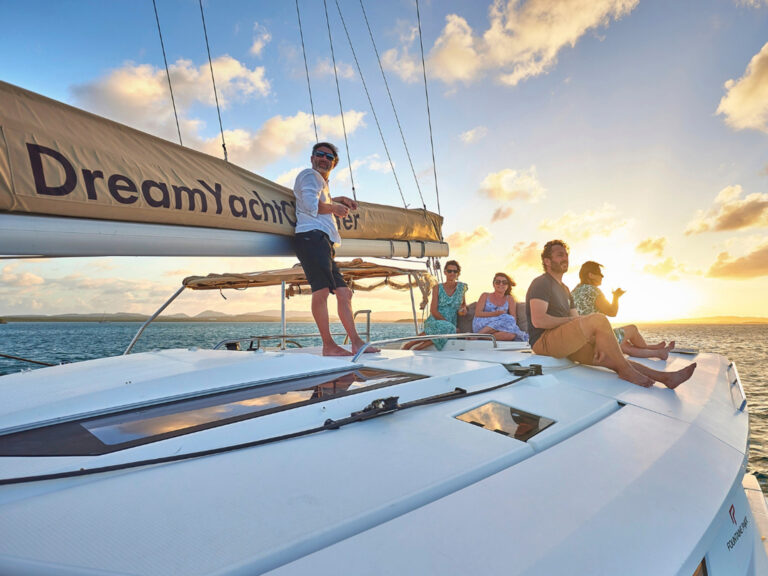
Options To Explore

For Sale: Little Harbor 63 Ketch
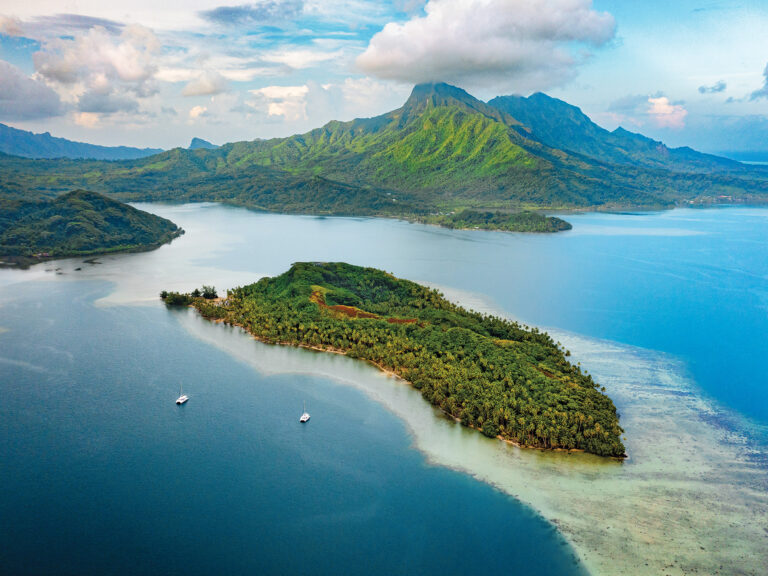
Cruising Tahiti: A Party in Paradise
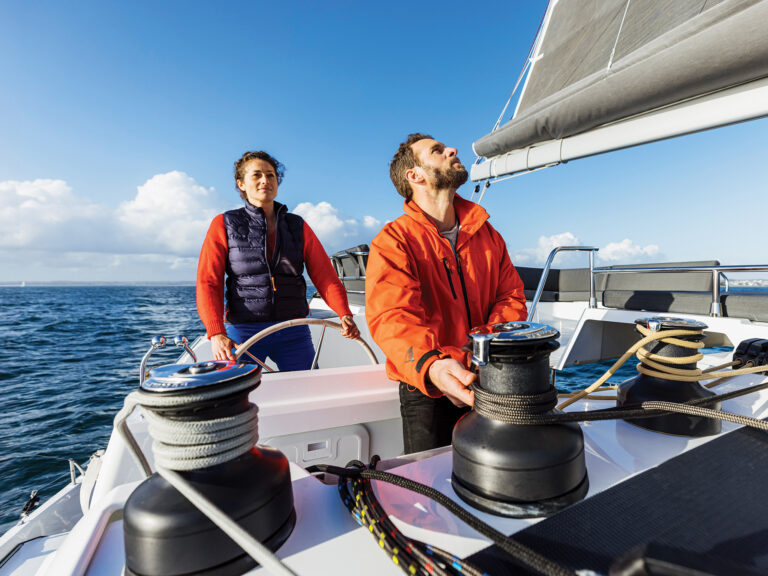
Sailboat Review: Fountaine Pajot Aura 51
- Digital Edition
- Customer Service
- Privacy Policy
- Terms of Use
- Email Newsletters
- Cruising World
- Sailing World
- Salt Water Sportsman
- Sport Fishing
- Wakeboarding
Blitzen’s Baddies aim for strong finish to 2024 Newport Yacht Club’s racing season
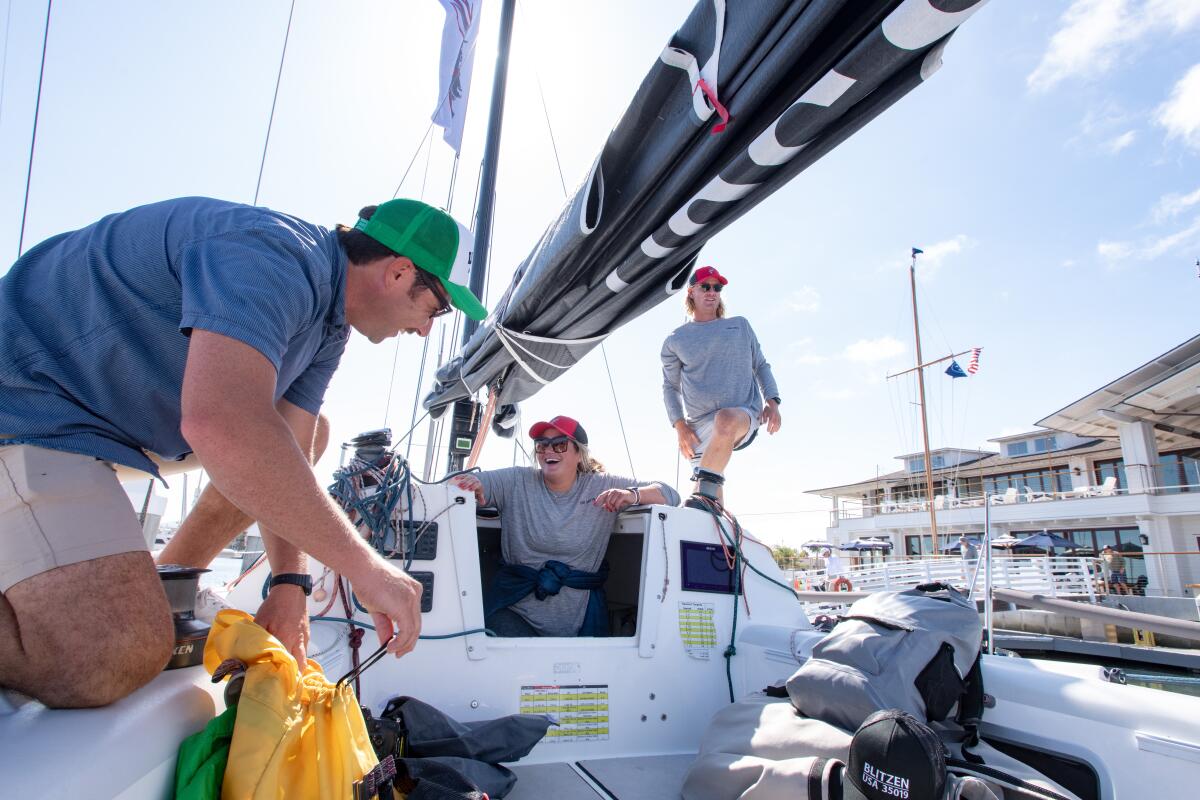
- Copy Link URL Copied!
Challenges confronted the crew of the Blitzen from day one in their inaugural year competing in the Newport Harbor Yacht Club’s racing season. Their halyard broke during the opening day race in May, sending the wind-catching kite propelling their boat from Long Beach Harbor to Newport Pier tumbling into the ocean.
“There was no hesitation between this team,” Blitzen’s owner Brett Scott said. “Everyone grabbed the kite and in 20 seconds it was up and flying again.”
She has been sailing since she was 5. But her first year at the head of a team has taught her a lot about managing schedules, the personalities aboard the boat and finances, she said.
“Whenever something breaks it adds up, so I’m definitely not doing this for the money,” Scott said with a laugh. “Don’t take investment advice from me. But we’ve really bonded as a team, and I think that’s our greatest achievement.”
There were plenty of smirks, side-eye and playful jabs as she and the crew rigged the Blitzen Friday in preparation of Long Point Race week. The three-day race is the last competitive event of the yacht club’s season.
The first leg starts in Newport Harbor and ends at Catalina Island. Boats then sail to the opposite end of the island and back on day two before returning to Newport Harbor on day three.
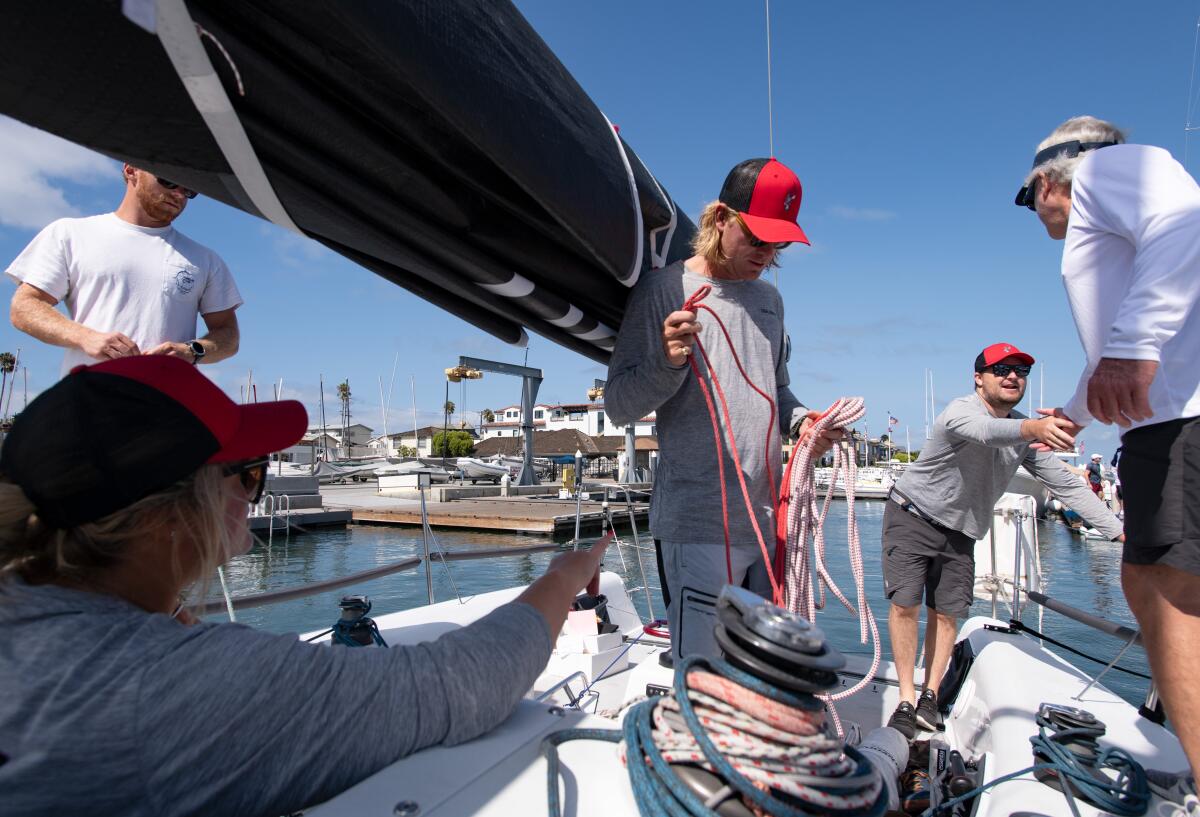
Blitzen’s Baddies, as the crew refers to themselves on Instagram, are all experienced sailors and were optimistic about finishing strong in their first season as a team. They’ve had some success this summer, including third-, second- and first-place finishes in their class during the three days of Long Beach Racing Week in June.
“We keep getting better,” Scott said.
Crew member Tyler Macdonald said the hardest part about the season has been “dealing with Adam and Spencer,” drawing laughs from Adam Bradley, Spencer Buchanan and the rest of the team aboard the Blitzen on Friday. Teammate Matt Whitfield said the real challenge of each race lies in “the hangover afterwards.” Coincidentally, he said his favorite activity while sailing is when they crack open some beer mid-journey.
There’s no shortage of banter aboard the Blitzen. And the irreverent sense of humor of her crew is half the reason Scoot chose to have them aboard.
She grew up in Reno and traveled to Newport Beach every summer as a child to sail with her family. She fell in love with both the ocean and the tavern-style warmth of the community that welcomed her into the sport.
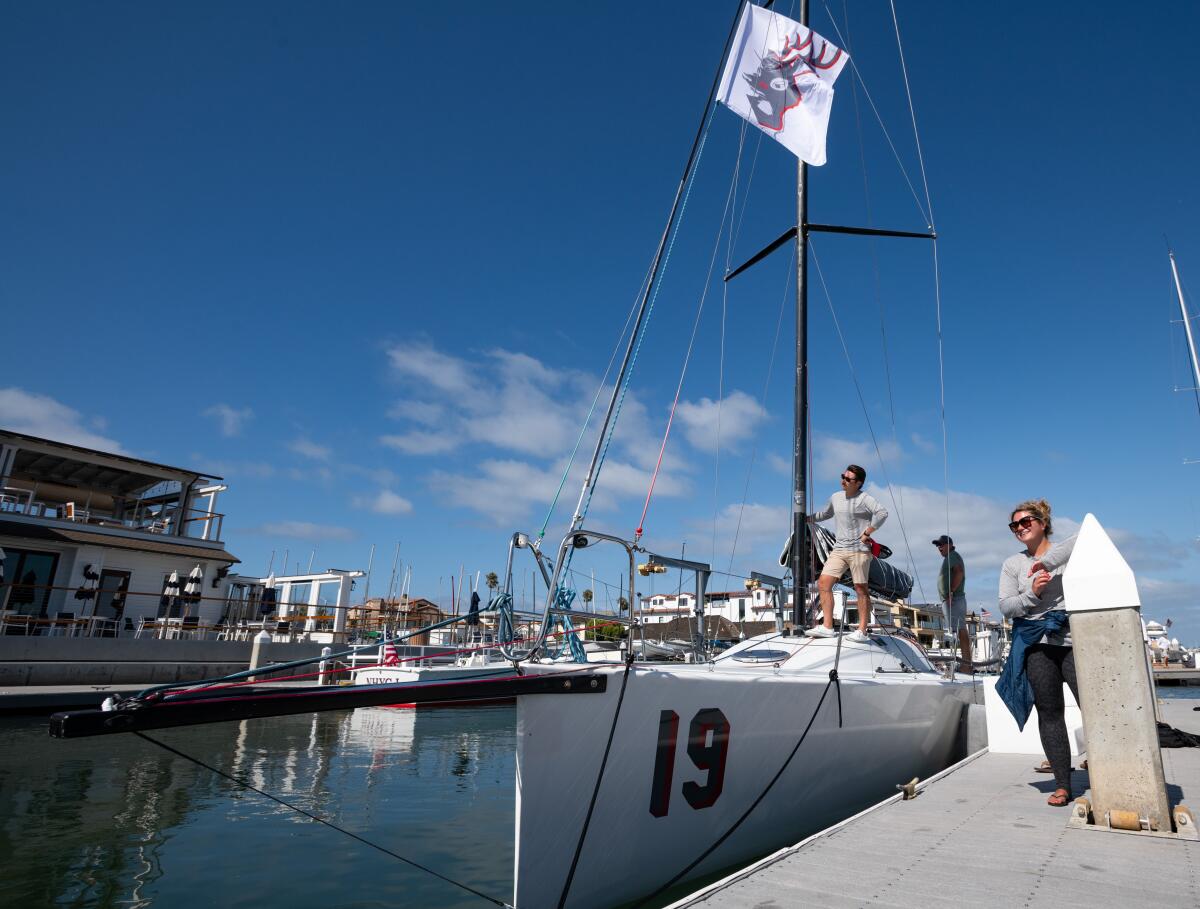
Her father, Bart Scott, said he wasn’t surprised to see her move to Newport Beach. He’s proud to see her fulfill her lifelong dream of owning a boat and fielding a racing team. And although she has a sense of humor, she runs a tight ship and commands the respect of her crew.
“Once we all come together on what a problem is there’s not a lot of back and forth or arguing,” Scott said. “They all just recognize what we each need to do and get it done.”
After Long Point, Blitzen’s Baddies plan on participating in small casual races while preparing for next season. They hope to compete in the Transpacific Yacht Race from San Pedro to Honolulu next July.
All the latest on Orange County from Orange County.
Get our free TimesOC newsletter.
You may occasionally receive promotional content from the Daily Pilot.

Eric Licas covers Newport Beach for the Daily Pilot. He previously was a crime and public safety reporter and, before that, spent four years as a staff writer with the Orange County Register and the Southern California News Group. He has been on the ground to cover active wildfires, civil unrest and mass shootings. He was born in the Philippines, raised in the San Fernando Valley and is a Cal State Northridge alumnus.

$600,000 awarded to help turn Randall Preserve into ‘world-class nature park’
Aug. 23, 2024

Kontrapunktus to tap into spirituality of music in return to Laguna Beach

Daily Pilot e-newspaper: Friday, Aug. 23, 2024

Huntington Beach city clerk race heats up
LISTEN TO THE PODCAST
Free masterclass, yachting courses, watch my free live masterclass "how to get a job on a yacht" .

back to blog
7 Ways To Nail Your First 7 Days As A Yacht Stew.
Freebie alert: Junior Stews Download now
![[PenelopeTemplate]taylor-simpson-azI_KfAnC8E-unsplash martini mondays public relations and strategy brisbane](https://static.showit.co/400/-j3kPzfNRjm8JSippHi7Dw/shared/penelopetemplate_taylor-simpson-azi_kfanc8e-unsplash.jpg)
Blog Categories
Superyacht jobs, life onboard, about yachting, listen now.
Hear about the real yacht life, info on how to kickstart your superyacht career and tips on becoming a super stew.
The Seaworthy Stew: Podcast
![[PenelopeTemplate]content-pixie-VIh-B-bNZMc-unsplash martini mondays public relations and strategy brisbane](https://static.showit.co/400/sgOjawVZS0WmIQiKY2Ntrg/shared/penelopetemplate_content-pixie-vih-b-bnzmc-unsplash.jpg)
A Chief Stew with 6+ years experience in the superyacht industry. I help aspiring crew confidently land their first job and teach the skills needed to be a stand out YACHT STEW.
Hey, I'm Jess
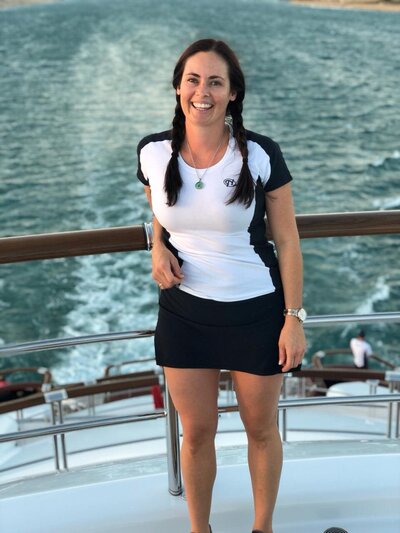
The best times to find work on a superyacht
About yachting , superyacht jobs, filed under:.

Tune in via
Listen now- check out the seaworthy stew podcast here.
The best times to find a job in yachting to give you the best chance at scoring work! 1. At an international event such as a boat show
2. When the yachts are in season
3. When there’s a change over of crew (generally at the start and end of a season)
All of these times are when work is the most prominent with jobs onboard.
So why is there more workaround when there is an international boat show or large luxury event? If a boat is for sale or up for charter it will be participating at the boat show to show off to potential buyers and charter agents.
When a yacht is getting ready for boat shows you can imagine it needs to look amazing! So it’s all hands on deck with often short turnarounds and extra hands needed its a prime opportunity to get some day work and help out onboard where needed.
Popular boats shows and events include the Miami International Boat Show in February , The Cannes Film Festival and Monaco Grand Prix in May, Sanctuary boat show on the gold coast Australia also in May, The Fort Lauderdale International Boat Show (Otherwise known as FLIBS) held in late October, and the Antigua Charter Yacht Show in December. I suggest doing a search online to find out more if you’re looking for work and an upcoming boat show or event is happening soon in the yachting hubs or close to where you’re based.
Now for the yachting seasons… the most important time to look for work!
Med Season (Mediterannean Season)- April/May – September/Oct The med season generally begins late April/early May when yachts are preparing for summer charters and events like the Cannes Film Festival held in May. In the lead-up to the season, there will often be opportunities for day work and permanent positions as vessels crew up for the season. Caribbean season Late November marks the beginning of the Caribbean season, with the Antigua Charter Yacht Show kicking things off in early December. Popular spots for yachts in the USA/Caribbean include Fort Lauderdale (Main yachting hub), West Palm Beach, Antigua, and St Maarten.
Dual Season Yachts (yachts that do both main yachting seasons)
The majority of dual-season yachts will begin their crossing back to the Med Feb/March to get ready for the summer season in the Mediterranean . Some yachts remain in the Caribbean as late as May. It all depends on the charters booked, owner preferences and schedules.
Yachting Seasons in Australia
The Whitsunday season including Great Barrier Reef charters generally run from April to November. From November to late January/February it is the busy summer season in Sydney.
Finding work at the beginning and end of a season is also prime time to look for work onboard. Yacht crew work all season, some leave some stay, some want a break and some will go and do training, therefore, positions become available.
Don’t leave it too late though when the season is all done – especially if it’s the med season as you could miss your opportunity to jump on a boat that is destined for the Caribbean or the states. The dual-season yachts leave soon after the season wraps up which can be anywhere from September- to October.
Want to know the three best times to find a job in yachting to give you the best chance at scoring work?
Are you wondering how to get a job on a yacht? How to find work as a yacht stew or deckhand?
Check out this episode! Yachting is seasonal, there are boat shows and events when more yacht crew are needed, and there’s a change over of yacht crew at the beginning and end of a season. It’s about timing it right to maximise job opportunities in the yachting industry.
Want to learn how to get a job on a yacht? Tools here >> The Yachting Kickstarter Guide Learn all the skills needed to become a professional Yacht Stewardess: Course here >> The Seaworthy Yacht Stewardess Online Training Course

listen to the podcast
About .
I’m a chief stewardess with over 6 years experience working in the superyacht industry on boats up to 88m. I help aspiring yacht crew by propelling them with the know-how and tools to confidently break into the superyacht industry.
Hey, I'm Jess a friendly Yacht Stew here to help!
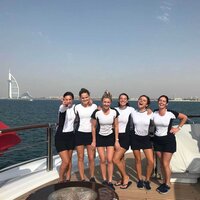
@THESEAWORTHYSTEW

privacy & terms
© 2020 the seaworthy stew, masterclass, listen on the podcast.
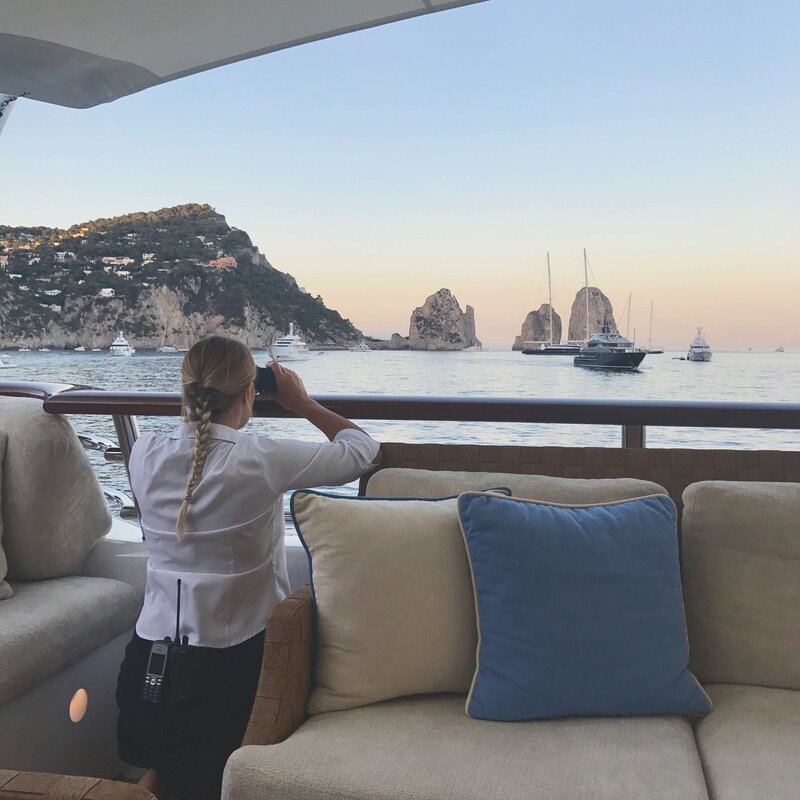
welcome, friend

- Find my AS Number
- News News News National News State News Subscribe
- About About About About Us Strategic Plan Constitution Member States Sport Integrity Policy Documents One Sailing Club Affiliation Fees Australian Sailing Number Annual Reports Club Survey Our Staff Career Opportunities
- Information & Services Information & Services Information & Services Resources Website Discover Sailing Website Australian Sailing Team Website
- Community Community Community Club in Focus Sailing Summit Sailing Awards Hall of Fame The Barranjoey Pin Training in Focus - Live Supported Organisations Host an Olympian
- Events Events Events Calendar Youth Championships Yachting Championships Sail Melbourne Sail Sydney Match Racing Australian Para Championships

Latest news

Upcoming events
|
|
- Inquire Now
- YACHT SEARCH
- Motor Yachts
- Sailing Yachts
- $1 – $25,000 Yachts
- $26,000 – $50,000 Yachts
- $50,000 – $100,000 Yachts
- $101,000 – $200,000 Yachts
- $200,000 – ∞ Yachts
- Virgin Islands
- Leeward Islands
- Turks and Caicos
- Spain & Balearic Islands
- New England
- Tahiti & South Pacific
- More destinations
- Charter Advice
How Long Is a Yacht Charter Season?
Every charter destination has a “yacht charter season,” which refers to the months when cruising conditions are ideal and charters are most popular. For example, some destinations have a summer season like the Mediterranean, while others are winter charter season destinations (like the Caribbean).
But you might be wondering: How long is a yacht charter season?
Both summer and winter chart seasons last roughly six months. Yet, within each season there are also “high,” “low” and “shoulder” seasons. In both summer and winter, “high” or peak charter season – the time when chartering is most popular – lasts just 2-3 months.
Wondering when you might plan your next charter? We’re taking a closer look at yacht charter seasons to show you how long they are, how seasons differ by region, and when peak charter season is.
Summer Yacht Charter Season
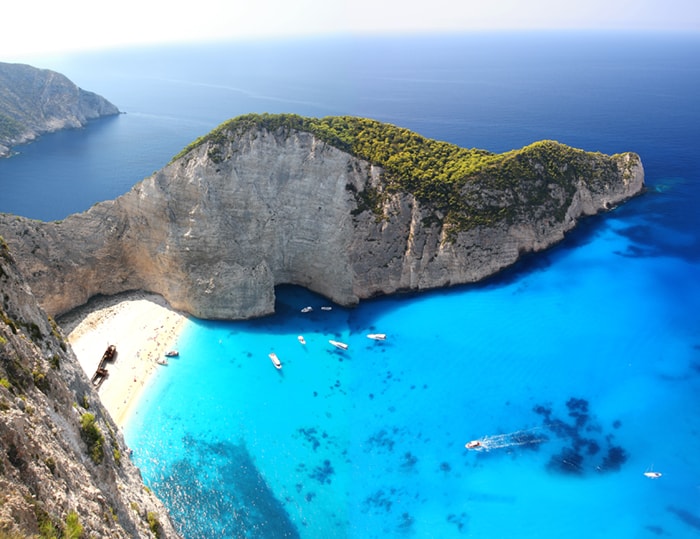
The Mediterranean is the world’s most popular summer yacht charter destination. The region’s beautiful temperate climate offers ideal conditions during the summer months, and hotspots like Cannes and the French Riviera, Italy, and Croatia beckon charter guests from around the world.
How long is the summer charter season?
Summer charter season in the Mediterranean begins in late-April and runs through mid-September. Summer in the Mediterranean not only brings warm, sunny weather; it’s also known for its many cultural affairs, like the Cannes Film Festival, the club season in Ibiza, and food and art festivals along the Amalfi Coast in Italy.
Throughout the Mediterranean, peak charter season is just two months: July and August. Many yachts are fully booked during the peak season, and rates climb by about 10%.
Alternatively, New England in the U.S. is another popular summer destination, yet the season is a bit shorter: from mid-June through August, with the high season running from mid-July to mid-August.
Popular summer charter destinations:
If you’re looking for a summer charter destination, spots throughout the Mediterranean offer respite from the heat and humidity. Top destination for summer yacht charters include:
French Riviera Known for its cosmopolitan beach clubs and rustic charms, the French Riviera – including Cannes, Monaco and Corsica – offer ideal summer cruising conditions. The French charter season mirrors most of the Mediterranean, but generally starts a bit later, in mid-May and runs through September. The summer season coincides with many events popular with charter guests, including the Monaco Grand Prix, the Cannes Film Festival, and Cannes Lions International Festival of Creativity.
Italy With numerous charter regions, including Sicily, the Amalfi Coast and the Italian Riviera, Italy might be the world’s most popular destination for summer charters. Italy offers a bit of everything: Excellent cuisine and wine, historic sites to explore, and plenty of culture and nightlife. Italy’s charter season runs May through October.
Croatia Croatia – and its numerous islands – make an ideal summer destination, thanks to cool breezes off the Adriatic and its warm sapphire waters. Throughout the season, Dubrovnik, Split and Hvar all beckon charter guests, who escape to Croatia’s sparkling beaches, and upscale, historic ports of call. Dubrovnik, the historic walled city, is a popular charter destination in the summer, and it hosts numerous festivals throughout the charter season.
Greece Sun-soaked Greece is home to nearly 10,000 miles of coastline, along with beautiful islands like Santorini. In the summer months, Greece offers plenty for charter guests to experience, including beautiful beaches, UNESCO sites, and excellent cuisine like moussaka and Restina wine. Greece’s charter season is a bit longer: from April through October.
Spain Spain’s Balearic Islands are a legendary summer season destination, thanks to the all-night clubs of Ibiza and the islands’ sun-soaked beaches. Spend a night clubbing in Ibiza, or explore neighboring Formentera, known for its natural landscapes and hiking trails. Majorca is another must-see island, known for its historic churches, swank beach clubs, and world-class dining.
New England From the coast of Maine, to Newport, R.I. and Martha’s Vineyard, the tranquil ports along the East Coast in the U.S. are perfect for summer charters. The destination offers it all: Cosmopolitan villages, classic lighthouses, excellent golf, windswept beaches, and National Parks to explore. Looking for another summer destination in the U.S.? Consider Alaska, which is known for its glaciers and natural beauty.
Winter Charter Season
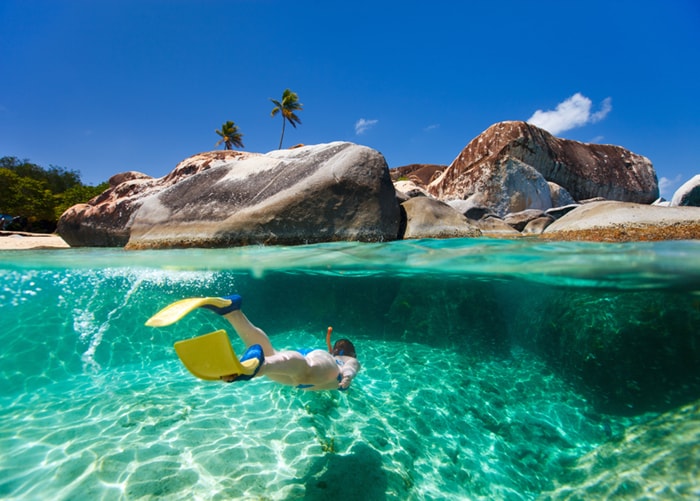
The Caribbean is a winter charter season mecca, as many escape the cold weather to the soak up the sun in the Bahamas, the Virgin Islands, Turks & Caicos, and the Grenadines. The Caribbean offers ideal cruising conditions throughout the winter months, including steady breezes (a must if you fancy a sailing charter), warm weather in the 70s and 80s, and hundreds of hidden beaches to explore.
Winter charter season is about six months long, and typically beings in late October, around the unofficial season kickoff, the Fort Lauderdale International Boat Show, and runs through March. Thailand, Tahiti and the Seychelles, and the South Pacific are also popular destinations for winter charters (and have a similar season to the Caribbean).
In the Caribbean, peak charter season is in late December, during the holidays, through March. The shoulder season in November and mid-December are popular as well and offer fewer crowds and reduced prices.
Popular winter charter destinations:
Winter charter destinations offer warm weather, beautiful beaches, and plenty to do and explore. If you’re considering a winter yacht charter, you might choose to travel to:
The Virgin Islands Both the U.S. and British Virgin Islands are some of the most visited islands during the winter season. Known for their laid-back island vibes, incredible sailing, snorkeling and diving, the Virgin Islands are perfect for an adventurous, island-hopping winter yacht charter.
Tahiti Tahiti has fast become one of the most popular charter destinations in the South Pacific, and it offers the ultimate in privacy and natural beauty. With islands like Bora Bora and Moorea, as well as black sand beaches, French Polynesia is the perfect destination for escaping the cold to snorkel, dive, hike and enjoy the beach.
Thailand Thailand’s beautiful islands and tropical coast offer the best in winter chartering. Thailand is perfect for snorkeling and island hopping, Full Moon parties and lazy beach days. The destination’s tropical climate, making for perfect winter charter conditions.
Turks & Caicos Upscale, yet unpretentious, Turks & Caicos – which is comprised of seven main islands, and more than 40 uninhabited cays and islets – is an ideal destination or winter snorkeling. The island’s beautiful coral reefs teem with colorful fish, rays, turtles, and sharks throughout the winter months.
Year-round Charter Destinations
Some destinations offer chartering year-round. For example, Florida is one of the most popular destinations, no matter the time of year.
The Bahamas With hundreds of islands to explore, there’s a new adventure around every corner in the Bahamas. Two of the region’s most popular charter destinations, Nassau (with its excellent golf courses, numerous beaches, and family-friendly atmosphere) and the Exumas (a stretch of beautiful islands), offer chances for R&R and adventures like swimming with pigs and sharks, cliff-diving, and snorkeling.
Miami & The Florida Keys Miami and the Florida Keys offer excellent cruising conditions throughout the year. The peak season in Florida is generally mid-December through March, yet a variety of luxury crewed charters in any month.
Want to learn more about the best charter seasons around the globe? Contact your charter broker with Worldwide Boat to learn more.
Showing 1–4 of 288 results
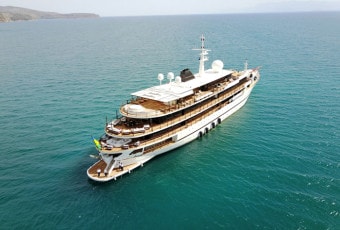
282.2ft / 84m
278.1ft / 83m
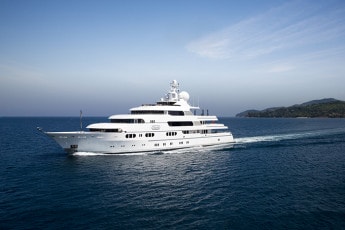
239.6ft / 71m
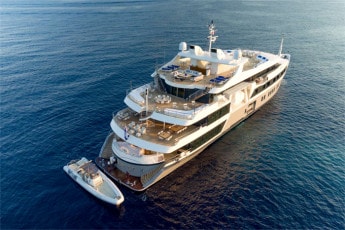
Serenity 236
236.3ft / 70m
Go to Charter Advice
Set your search criteria to find the perfect yacht
- Alaska Australia Bahamas BVI Caribbean Croatia Florida France Galapagos Greece Indonesia Italy Malaysia Maldives Mexico Mediterranean New England Norway Spain Thailand Tahiti Turkey
- Motor Yacht Catamaran Sailing Boats
- 2 4 6 8 10 12 12+
Search by yacht name
Daily Briefing: The uncommitted delegates
The Harris campaign refused a request from a group of uncommitted delegates to give a Palestinian-American a speaking slot on stage at the Democratic National Convention. Vice President Kamala Harris has officially accepted her party's nomination. The last corpse recovered from a sunken superyacht.
🙋🏼♀️ I'm Nicole Fallert , Daily Briefing author. It is definitely wayyy too early for pumpkin spice (*sips PSL*).
Gaza war protesters made a final bid for recognition
Stymied in their demand that a Palestinian-American be allowed to speak to the Democratic National Convention about the war in Gaza, a group of uncommitted delegates ended a protest outside the United Center on Thursday with a new request: that Vice President Kamala Harris meet with Arab-Americans and Muslims in Michigan and elsewhere.
They also set a deadline for such a meeting or meetings to take place on Sept. 15.
- Failing to meet with advocates could have ramifications for Harris, such as losing essential votes in some swing states, like Michigan, which have large Arab-American and Muslim communities.
- The pressure on Harris over the devastation in Gaza isn't only coming from the streets . Uncommitted delegates locked arm in arm and attempted to enter the convention floor but were reportedly barred from returning to their seats.
- It was a mistake the DNC did not feature a speech by a Palestinian-American, said Congressman Ro Khanna, D-Calif., a rising progressive star and an adviser to Harris.
Meanwhile, inside the United Center, Kamala Harris becomes the nominee
Democrats positioned themselves as the patriots' party on the final night of the DNC in Chicago. Flags waved as the party turned to military veterans and national security officials to cast former President Donald Trump as a threat to the country and someone who has disrespected veterans. Then, Kamala Harris took the stage to officially accept her party's nomination, presenting herself as someone who is "no stranger to unlikely journeys." The vice president, a child of immigrants, is the first Black and South Asian woman nominated by a major party. Read USA TODAY's recap of Harris' speech in Chicago last night.
More news to know now
- Here's what Kamala Harris will do about the border .
- Russia is weeks away from responding to Ukraine's incursion .
- Your college student may be paying thousands in fees for a service they don't need .
- Hurricane Gilma tracker: See the projected path of Category 3 storm .
What's the weather today? Check your local forecast here .
Body of last missing person found after Sicily superyacht sinking
Italian rescue divers on Friday found the body believed to be the daughter of British tech magnate Mike Lynch. The Bayesian, a 184-foot luxury sail boat carrying 22 passengers and crew, was anchored near Palermo when it capsized and rapidly sank after being struck by a pre-dawn storm on Monday. The bodies of the other five dead passengers, including Lynch, were recovered on Wednesday and Thursday from inside the yacht. Read more
COVID-19 vaccines are updated and ready for fall
Major retailers like Walgreens and CVS will shortly begin stocking millions of updated COVID-19 vaccines after the shots received approval by the U.S. Food and Drug Administration this week. The updated vaccines from Pfizer and Moderna for people aged 6 months and older come amid a summer surge in COVID-19 cases across the U.S. Getting the shot now will offer protection when the anticipated winter surge comes and other respiratory illnesses become more prevalent, as people congregate indoors. Read more
Keep scrolling
- "Pommel horse guy" has joined "Dancing with the Stars."
- Here's how to stay alive in your fantasy football pool .
- Beyoncé has asked Trump to cease and desist using her song "Freedom."
- Three years after a dognapping, Lady Gaga finally got a new pup .
- Should you and your partner sign a pet prenup ?
College Football season is about to kick off
Deeper conferences. More games. An even tougher road to the national championship under the 12-team College Football Playoff format set to debut this season. It's become harder than ever to post an unbeaten record. That's why there isn't one team — not Ohio State, not Texas, not even Georgia — picked to run the table in the USA TODAY Sports predictions. Read more
Photo of the day: Swinging on America's court
Matches in the last couple of weeks suggest tennis stars who played in the Olympics came back physically and emotionally drained while those who skipped Paris enter the U.S. Open in better form. Those dynamics set up a fascinating tournament in New York where it seems like there could be some chaos and early-round upsets.
Nicole Fallert is a newsletter writer at USA TODAY, sign up for the email here . Want to send Nicole a note? Shoot her an email at [email protected] .
We've detected unusual activity from your computer network
To continue, please click the box below to let us know you're not a robot.
Why did this happen?
Please make sure your browser supports JavaScript and cookies and that you are not blocking them from loading. For more information you can review our Terms of Service and Cookie Policy .
For inquiries related to this message please contact our support team and provide the reference ID below.
How to watch 'Love Island USA' Season 6 reunion: Everything you need to know

After another season of love and heartbreak, the season six cast of "Love Island USA" will come together to hash out lingering drama for the reunion episode.
"Love Island USA," which is a spin-off of a reality show of the same name from the U.K. , brings singles together in a Fijian villa for a chance at finding their next partners. Contestants, dubbed "islanders," couple up, get dumped and face various challenges over the course of six weeks. During the finale, the public chooses a winning couple to win $100,000.
This show's USA version debuted in 2019 on CBS. After its first three seasons, the show moved to Peacock (NBCUniversal is the parent company of Peacock and NBC News.)
Many fans online have already speculated that the reunion will be full of drama. Videos of the islanders addressing their relationships and experiences with bullying circulated on social media after the taping of the reunion last week.
Here's what to know about the reunion.
How can I watch the reunion?
The "Love Island USA" reunion, which was taped in New York City last week, will be available to stream on Monday at 9 p.m. ET/6 p.m. PT on Peacock.
For those who need a refresher or want to join in the conversation, all episodes of "Love Island USA" season six are available to stream on Peacock.
Who will be in attendance?
Winners Serena Page and Kordell Beckham will be at the reunion, alongside other fan-favorite couples and contestants.
The "Love Island USA" X account shared some of the other islanders who attended the reunion taping last week.
Runners-up couples Leah Kateb and Miguel Harichi; JaNa Craig and Kenny Rodriguez; and Nicole Jacky and Kendall Washington are expected to appear.
Fans online have speculated that there will be a dramatic confrontation between couple Kaylor Martin and Aaron Evans, who reportedly broke up after the conclusion of the show, according to People.
Other big characters expected to be at the reunion include: Olivia Walker, Rob Rausch, Andrea Carmona and Daniela Ortiz Rivera.
"Vanderpump Rules" star Ariana Madix will return as a host for the reunion.
What has the fan response been to this season?
This season has been regarded by fans as one of the best seasons to date. The show became the No. 1 reality series in the U.S. across streaming, according to a press release from NBCUniversal in July.
Peacock reported that streaming reach for season 6 is double that of previous seasons.
But the show's popularity has also led to increased levels of scrutiny on the contestants.
Daniela Ortiz Rivera, who was in a controversial love triangle this season, posted a video on TikTok and Instagram raising awareness to bullying and suicide prevention after seeing the response to the show.
"All the hate that people are getting breaks my heart so much because at the end of the day, these people are not characters, they're real people with real feelings," she said in her video.
Ahead of the reunion, a statement shared on the "Love Island USA" X and Instagram accounts encouraged fans to "end the season with the same love and respect we started with!"
"the reunion is full of drama, but remember — these are real people, so let's keep it kind and positive," the statement read.
Daysia Tolentino is a culture and internet reporter for NBC News.
Ohio State football plans to start Nick McLarty at punter in season opener against Akron

Ohio State is preparing for Nick McLarty to start at punter in its season opener against Akron on Aug. 31 .
“As we head into the weekend, he is the starter,” Buckeyes coach Ryan Day said, “and the plan is for him to be the first punter to go out in the game.”
Since preseason practices began earlier this month, McLarty, a strong-legged freshman from Australia , has been competing with Anthony Venneri, previously the starting punter at Buffalo before transferring to Ohio State this past spring, and Joe McGuire, a returning sophomore.
Day said McLarty, who did not enroll at the school until June, has made a smooth transition to the United States and the sport at large. McLarty grew up playing Australian rules football.
“His hang time has been good,” Day said, “and he’s been more consistent. He’ll kick a few that’ll just go right out of the stadium. He’s just got a strong, strong leg. So we’re looking for that consistency. He’s shown that recently. He’s got the upper hand.”
More: Join the Ohio State Sports Insider text group with Bill Rabinowitz, Joey Kaufman Adam Jardy
The adjustments for McLarty have also included quickening the pace of punts. His 6-foot-7 size leaves him with a strong right leg, but also require a faster motion in order to boot the ball.
“The ball has to get off his foot faster,” Day said. “I think he’s done that.”
McLarty would replace Jesse Mirco, who had been the Buckeyes’ starting punter since 2021 before transferring to Vanderbilt in January .
Mirco had also been an Australian rules football player who was converted into a punter.
Joey Kaufman covers Ohio State football for The Columbus Dispatch. Follow him on X, the platform formerly known as Twitter, @joeyrkaufman or email him at [email protected] .
Get more Ohio State football news by listening to our podcasts
Please use a modern browser to view this website. Some elements might not work as expected when using Internet Explorer.
- Landing Page
- Luxury Yacht Vacation Types
- Corporate Yacht Charter
- Tailor Made Vacations
- Luxury Exploration Vacations
- View All 3697
- Motor Yachts
- Sailing Yachts
- Classic Yachts
- Catamaran Yachts
- Filter By Destination
- More Filters
- Latest Reviews
- Charter Special Offers
- Destination Guides
- Inspiration & Features
- Mediterranean Charter Yachts
- France Charter Yachts
- Italy Charter Yachts
- Croatia Charter Yachts
- Greece Charter Yachts
- Turkey Charter Yachts
- Bahamas Charter Yachts
- Caribbean Charter Yachts
- Australia Charter Yachts
- Thailand Charter Yachts
- Dubai Charter Yachts
- Destination News
- New To Fleet
- Charter Fleet Updates
- Special Offers
- Industry News
- Yacht Shows
- Corporate Charter
- Finding a Yacht Broker
- Charter Preferences
- Questions & Answers
- Add my yacht
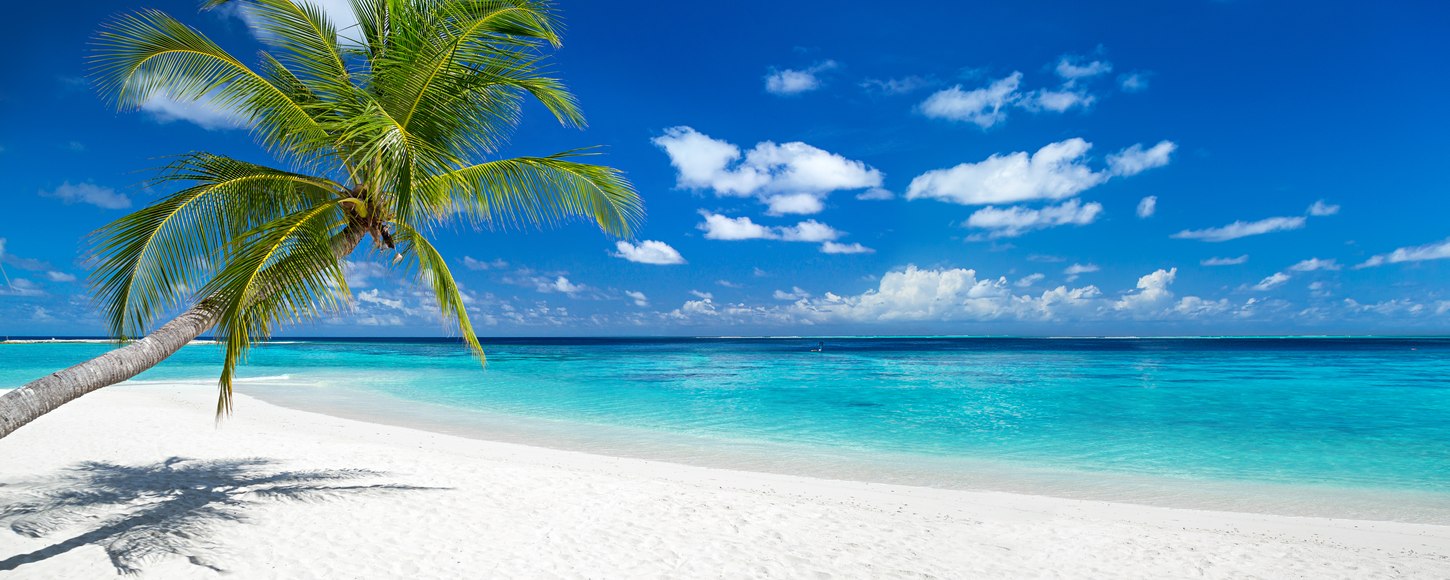
- Yacht Charter Fleet
- Luxury Yacht Charter Advice
Yacht Charter Seasons
- Share this on Facebook
- Share this on X
- Share via Email
By Editorial Team 24 January 2023
Whether you’re looking to escape the brisk winds of winter or the humid climates of summer, it is important to understand charter seasons and how they may affect the planning of your luxury yacht charter .
In this article:
- Types of yacht charter seasons
Shoulder seasons
Charter seasons in popular destinations, weather and charter seasons, extreme weather, a yacht for all seasons, all weather cruising, major sporting & social events, need more advice.
A charter season can refer to the weather pattern of a destination or the peak times when demand for charter yachts is at its highest. Read on to discover everything there is to know about charter seasons and the best times to travel.
What are yacht charter seasons?
In terms of yachting, there are two main types of charter seasons in the year – summer & winter and high & low season;
- When referring to a charter season in terms of weather and climate, the seasons are broken into summer and winter.
- When speaking in terms of peak times in the yachting calendar, the seasons are high and low (sometimes referred to as peak and off-peak), where high season is the busiest and low season is the quietest.
These are the months that straddle either side of the seasons, in other words: April & May and September & October, and can be a great time to charter a yacht. Here are some of the reasons why;
- Demand for yachts is generally lower
- Charter fees are often in-line with low/off-peak season rates
- More berths and anchorages are available
- Popular destinations tend to be less crowded
- The weather is still reasonably warm
- The seas are at their warmest at the end of summer

Throughout the world different regions will have different peak seasons for yacht charters, for example the Caribbean yacht charter season generally runs from December through to March, with its peak season occuring during the Christmas and New Year holiday period.
For the Mediterranean , the charter season runs from May till late September, with July & August representing the busiest peak months.

Some regions claim year-round cruising, especially equatorial destinations offering consistent balmy temperatures such as Thailand or the Maldives . However, these yacht charter regions also experience peak times around their respective monsoon seasons (see below).
Charter seasons are not just affected by the temperatures, they are also dictated by the overall weather and sea conditions.
Weather plays a crucial role in any yachting vacation, and bad weather can not only mar the enjoyment and comfort of a yacht charter, but also hugely impact on any planned itinerary.

Obviously, inclement weather can occur at any time of the year, however most destinations will have optimum times to visit largely dictated by their own annual weather patterns, such as the monsoon seasons in Asia and the Pacific , which occur roughly between May and October. Or, the Meltemi winds in Greece , which blow a strong yet fairly predictable wind across the Aegean, mainly around the Cyclades Islands , throughout July and August – although these winds can prove ideal for sailing yacht enthusiasts!
Some inclement weather conditions for yacht charters can occur at any time, like the mistral winds of the Mediterranean, particularly around Corsica and Sardinia , and so it is always wise to factor in some flexibility into your planned itinerary to contend with any unexpected bad weather.
Some popular yacht charter destinations can experience extreme weather conditions, such as tropical cyclones in the Indian Ocean or huge bushfires in Australia which can affect the air quality even out to sea, however these tend to be rare events.
An obvious example of predictable extreme weather is the annual hurricane season which occurs around the celebrated charter destination of the Caribbean, and some southern US states, roughly between June to mid-October.
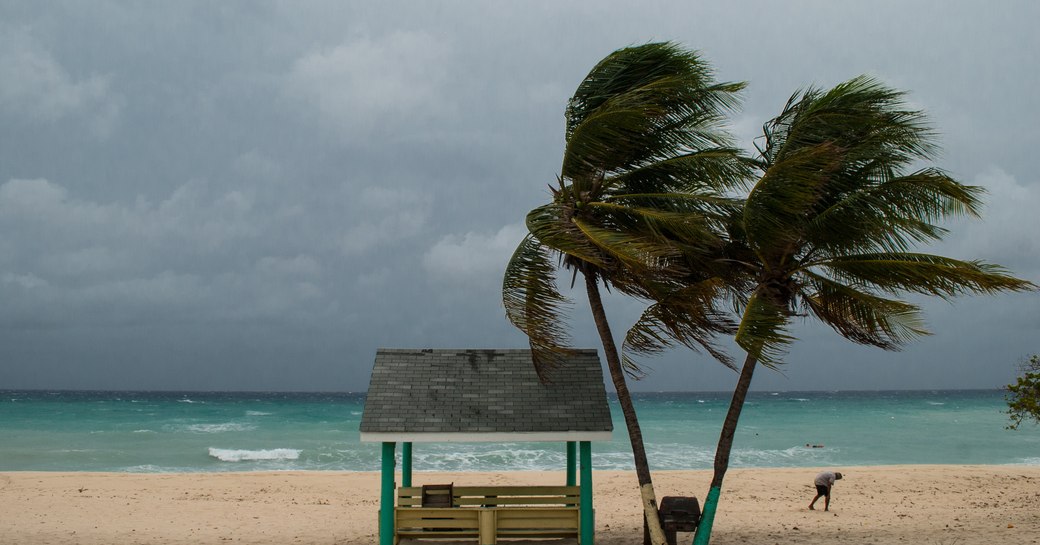
Most charterers avoid booking during this period for obvious reasons, however with reduced charter rates and a wider selection of yachts at your disposal you may be tempted to take the risk.
Hurricane addendum
Happily, there is a standard addendum that can be added to a basic charter contract that allows you to reshedule your yacht charter in the event of a hurricane hurtling towards your chosen destination!
Your yacht charter broker will also likely advise the purchase of additional cancellation insurance for peace of mind if you are planning a yacht charter during the hurricane season.

In general, seasonal weather will affect the location of most crewed yachts, which tend to move from one region to another in line with the charter seasons.
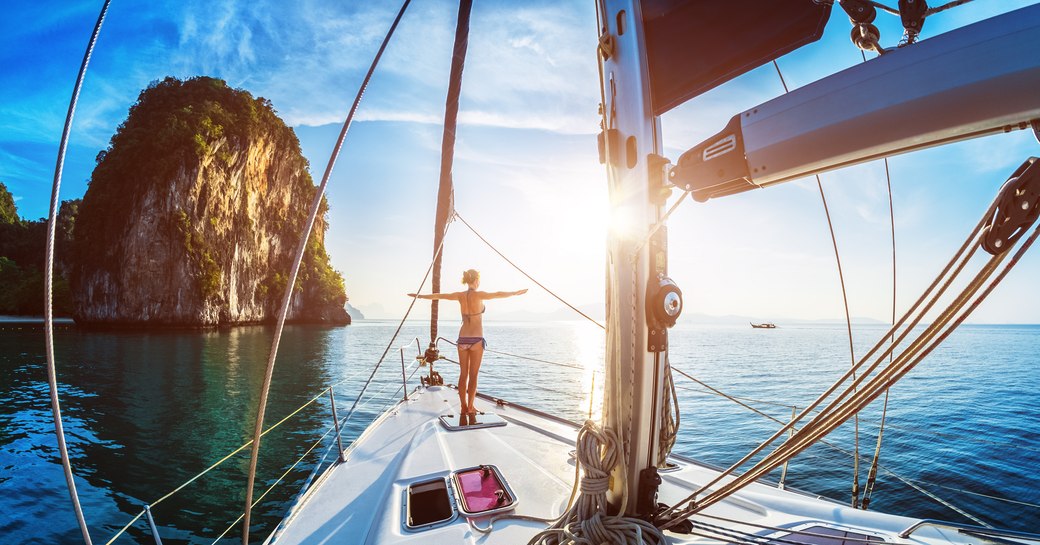
Therefore, when choosing a charter destination it is best to establish the optimum cruising months as there will generally be a wider selection of yachts to choose from, subject to demand. For instance if you’re looking to charter in Alaska , be aware that come winter season there are very few marinas open.
The majority of charter yachts are built around demand for predominantly warmer climates such as the Caribbean or Mediterranean, and are therefore far less likely to have heating installed.
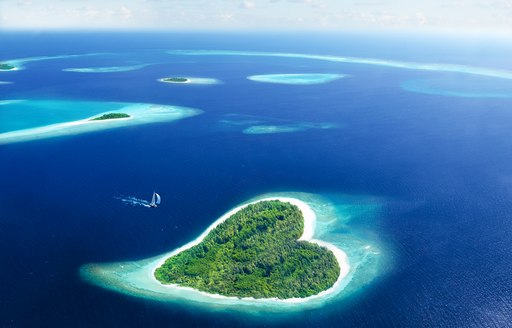
There are of course a number of charter yachts that cater for all seasons, in particular expedition yachts which are specially designed to handle all weathers, no matter how extreme. If you are keen on exploring far-flung corners of the globe, from the arctic poles to the sultry heat of the tropics, these types of yachts are ideal.
Important events in the yachting calendar, such as the Monaco Grand Prix and Cannes Film Festival , are considered high season events, whether or not they actually occur in high or low season. This is because charter yachts are in greater demand during these times, with a marked increase in charter rates as a result of their limited availability.

Whether you're looking to charter in the summer, winter or all year round, take a look at our comprehensive destination guides which offer lots of useful information, including optimum times to charter a yacht around your chosen destination.
For more advice about yacht charter seasons, please speak with your preferred yacht charter broker .
For any further information about booking or chartering a luxury yacht, please take a look at our comprehensive advice guides .
Related advice articles

- Share on Linked In
Yacht Reviews
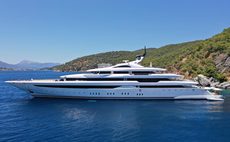
- See All Reviews

Charter Yacht of the week
Start Planning - Speak with a Charter Expert
Our charter experts will:
- Discuss your vacation plans
- Check availability & shortlist suitable yachts
- Negotiate booking & prepare your itinerary
Enquire now for yacht availability & free consultation.
Featured Luxury Yachts for Charter
This is a small selection of the global luxury yacht charter fleet, with 3697 motor yachts, sail yachts, explorer yachts and catamarans to choose from including superyachts and megayachts, the world is your oyster. Why search for your ideal yacht charter vacation anywhere else?

136m | Lurssen
from $4,446,000 p/week ♦︎
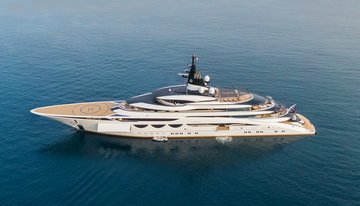
115m | Lurssen
from $2,895,000 p/week ♦︎
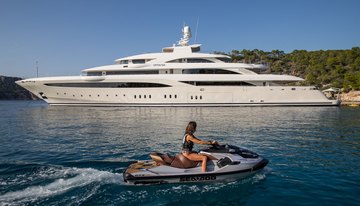
85m | Golden Yachts
from $1,000,000 p/week ♦︎
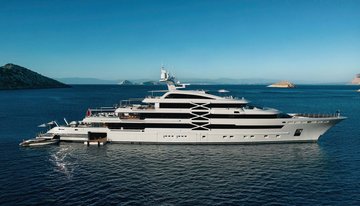
88m | Golden Yachts
from $1,223,000 p/week ♦︎
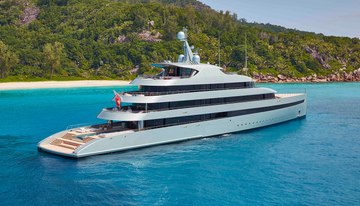
84m | Feadship
from $1,111,000 p/week ♦︎

93m | Feadship
from $1,556,000 p/week ♦︎
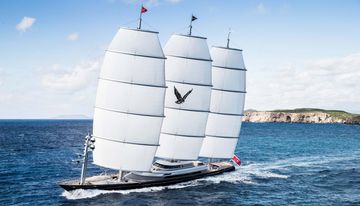
Maltese Falcon
88m | Perini Navi
from $490,000 p/week
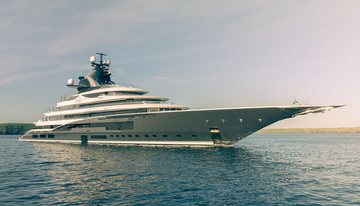
122m | Lurssen
from $3,000,000 p/week
As Featured In
The YachtCharterFleet Difference
YachtCharterFleet makes it easy to find the yacht charter vacation that is right for you. We combine thousands of yacht listings with local destination information, sample itineraries and experiences to deliver the world's most comprehensive yacht charter website.
San Francisco
- Like us on Facebook
- Follow us on Twitter
- Follow us on Instagram
- Find us on LinkedIn
- Add My Yacht
- Affiliates & Partners
Popular Destinations & Events
- St Tropez Yacht Charter
- Monaco Yacht Charter
- St Barts Yacht Charter
- Greece Yacht Charter
- Mykonos Yacht Charter
- Caribbean Yacht Charter
Featured Charter Yachts
- Maltese Falcon Yacht Charter
- Wheels Yacht Charter
- Victorious Yacht Charter
- Andrea Yacht Charter
- Titania Yacht Charter
- Ahpo Yacht Charter
Receive our latest offers, trends and stories direct to your inbox.
Please enter a valid e-mail.
Thanks for subscribing.
Search for Yachts, Destinations, Events, News... everything related to Luxury Yachts for Charter.
Yachts in your shortlist
Summer heat arrives in August, threatening to break all-time Australian winter temperature records
Topic: Weather Forecasts
Swimmers and surfers hit beaches across Sydney as an unseasonal warm winter spell spread from Australia's interior. ( ABC News: Berge Breiland )
Extraordinary August heat is developing across Australia, causing temperatures to spike up to 16 degrees Celsius above average while threatening all-time seasonal records in multiple states.
The unseasonable warmth is the result of a sudden contraction of cold fronts to Australia's south, which has allowed hot air to gradually build over the country's north and outback during the past week.
A warm winter air mass that's spreading from Australia's interior is bringing summer temperatures that could break all-time seasonal records. ( ABC News: Berge Breiland )
This warm winter air mass over the interior is now also spreading to south-east states — a pattern forecast to intensify into this weekend.
While the early winter thaw comes as a pleasant surprise for many, it has forced the ski season into a nosedive, leading to the lowest August snow depth in 18 years.
Temperatures to soar to record winter highs
Winter temperature records are likely to be annihilated across the country's interior during the coming days.
Take Alice Springs as an example — the town has an August average maximum of 23C, but is forecast to exceed 32C for the next seven days.
Bondi local Tawhid Islam sweating it out during the warm conditions. ( ABC News: Berge Breiland )
Including Wednesday's 32.3C, that will make eight consecutive days above 32C, easily eclipsing the current winter records of five days from 2009 and six days from 1880.
All-time individual daily records are also under threat across the outback this weekend including:
- Oodnadatta with 38C on Friday and Saturday — winter record 36.5C
- Alice Springs with 35C from Friday to Sunday — winter record 35.2C
- Tibooburra with 34C on Saturday and Sunday — winter record 34.1C
- Broken Hill with 30C on Saturday — winter record 31.5C
- Mildura with 29C on Sunday — winter record 29.9C
This weekend will bring temperatures in the mid- to high-30s across central Australia, challenging all-time winter records ( ABC News: Tom Saunders )
The heat building across the interior is also being carried to south-east states in a warm north-westerly flow.
After Sydney climbed to 26C on Wednesday, 8C above normal for August and equal to the average in mid-summer, the city then slept through its 14th consecutive night above 10C, the longest streak of double digit winter minimums since 1967.
While temperatures are already feeling spring-like for our capitals, the warmest weather is still ahead, including forecasts of:
- 24C in Adelaide on Friday — 8C above average
- 22C in Melbourne on Saturday and Sunday — 7C above average
- 21C in Canberra on Saturday and Sunday — 8C above average and its warmest winter day in nine years
- 27C in Sydney on Wednesday — 9C above average
- 31C in Brisbane on Wednesday — 9C above average and warmest winter day in seven years
The national all-time winter record of 41.2C, from West Roebuck in 2020, is also under threat early next week as temperatures across the Kimberley soar above 40C.
Sydney woke to 17C on Wednesday, the typical dawn temperature in December. ( Supplied: Tim Ritchie )
A sting in winter's tail
So with only 10 days remaining in winter and the country baking through unseasonable heat, does that mean cold weather is now behind us for 2024?
The short answer is a definitive no for southern states, as late winter, spring and even early December often bring bursts of polar air from the south interspersed with spells of dry heat from the north.
Gordons Bay in Sydney was warm on Thursday but a cold snap is expected to follow in the next week. ( ABC News: Berge Breiland )
This infamous variability will be on full display late next week with modelling indicating the current warm air mass will be replaced by icy winds from deep in the Southern Ocean.
Cooler air should gradually erode the heat across South Australia and Victoria from Wednesday to Friday, then sweep into New South Wales and the central interior by next Saturday.
The polar air mass is too far ahead for a precise forecast of the severity of the cold snap, however the system has the potential to rival the icy blasts from July.
Peak season across the alps has seen a significant snowmelt this August. ( Supplied: Selwyn Snow Resort )
Snow season melting away
While most Australians are rejoicing through the winter warmth, the heat has brought a rapid deterioration of the alpine snow cover and threatens to shorten the ski season for the second consecutive year.
Temperatures at alpine resorts during the past week have peaked near 10C and the latest measurement of natural snow depth in both NSW and Victoria is now the lowest since 2006 for the third week of August.
The early thaw will accelerate further during the coming week as temperatures remain well above freezing, with snow melt enhanced further by several bursts of upcoming rain.
The potential early finish to the season is reminiscent of last year when the warmest August on record across the alps abruptly closed most ski resorts weeks before the traditional finish in early October.
While there is hope of a recovery when colder weather arrives late next week, it will take several heavy snowfalls to restore the snow pack and its now a near certainly this year's peak season arrived in late July — about a month earlier than average.
The maximum snow depth measured by Snowy Hydro at Spencers Creek is therefore likely to be recorded as 124.6cm this year, 72cm below the long term average and the seventh lowest on record, according to data to 1954.

IMAGES
COMMENTS
The boat can be safely left in Australia while you fly home, or you can keep sailing. The most important thing to consider is to stay below 30°S; the official cyclone belt lies to the north of ...
The sailing season dates for popular destinations: The Caribbean: midwinter and early summer (December - January or March - June) The Mediterranean: April - October, although the winter is fine as well. Australia: May - October. UK: throughout the year. South Pacific: mostly May - October.
July 1, 2021. Ahoy Club News Whens The Best Time To Charter In Australia. Thanks to its large size and position on the globe, Australia is perfect for chartering all year round. While the main peak season runs between October and March, different regions offer different conditions making it the perfect all-year-round charter destination.
Orpheus Island. The places you will stop are the nicest part about sailing on Australia's east coast. The following is a list of some of the best anchorages and mooring spots along the Queensland coast: Whitsunday Islands (Brampton, Outer Newry, Goldsmith) Whitehaven Beach, Whitsundays. South Molle Island, Whitsundays.
Enquire now for yacht availability & free consultation. Australia weather and local climate guide for luxury yacht charter vacations including sea temperature, wind speeds for sailing yacht charters, hours of sunshine and average monthly temperatures.
Sailing contains so many variables that every passage is different. ... We sailed into Australia from New Caledonia at the start of the cyclone season in November 2022, and spent three months in a ...
Turkey. Turkey is arguably one of the best destinations to check out by yacht in August, thanks to its blissful daily average temperature of 33°c, clear skies and gentle ocean breezes. When it comes to the most popu lar places to drop anchor and explore the best that this Eurasian country has to offer, Bodrum and Fethiye take the top spot.
The safe sailing season in the South Pacific is well defined, with the weather usually fairly benign in the eastern part of this vast ocean. ... Those who intend to spend the cyclone season in Australia should continue west from Fiji and sail to a port in the Australian states of New South Wales or southern Queensland. Both Vanuatu and New ...
Lake Macquarie is one of the top sailing destinations of New South Wales. Located just 150 kilometres north of Sydney, the lake connects with the Pacific Ocean on its east side. Lake Macquarie is pooled with sandy inlets and secluded bays perfect for sailing, swimming and snorkeling. Four times as big as Sydney Harbour and extremely quiet, Lake ...
The average September temperature in the Whitsundays is 25.4 degrees (celcius), which means it's perfect weather for a luxury yacht charter. Some of the most popular destinations in the Whitsundays include Hamilton Island, Neck Island, Whitehaven Beach, Hook Island, Bait Reef Lagoon, Butterfly Bay, Hayman Island and Stonehaven - each ...
With so many options available, there's something to suit every type of budget. For convenience we have listed the average prices for motor yacht and sailing yacht charters in the Australia below; For motor yacht rentals in Australia, prices can range from $81,578 to $784,092 per week, plus expenses. For luxury sailing yacht rentals in ...
One of Australia's Leading Yacht Agents, providing luxury Superyacht Charters and Yacht Hire Services in Sydney, Australia and International Locations. ... The Whitsundays yachting season is in full flow and there is a fantastic fleet of superyachts based in the region. Take advantage of a diverse selection of yachts to build…
Australia yacht season and weather Located in the Southern Hemisphere, Australia offers warmer temperatures and sunnier days during what would be the cold winter season in higher latitudes. The Great Barrier Reef and The Whitsundays offer ideal sailing conditions during Australia's winter months, from April to November before the wet season ...
With over 50,000 km of coastline linked by more than 10,000 beaches boasting world-class marinas and ports, choice and diversity is a strong theme of any luxury yacht charter adventure Down Under. Sydney 's fantastic natural harbour offers a gateway into a melting pot of experiences within this dynamic city, from the Sydney Opera House to a ...
Australia Yachting Season. May through October are the most popular months for yacht charters, with the famous sailing race in August (Audi Hamilton Island Race Week) December will cater to some great yacht rentals, including Christmas and New Years' and into January. The weather is very stable, winds are low, rain is generally not prominent ...
By Kevin Green. April 19, 2022. Back in Oz. A race fleet sails into Port Stephens, the popular and pristine cruising region located approximately a two-day sail north from Sydney. Kevin Green. Our Contessa 25, Skyebird, lay at its mooring in Sydney Harbour, looking forlorn after my year trapped overseas amid the COVID-19 pandemic.
The three-day race is the last competitive event of the yacht club's season. The first leg starts in Newport Harbor and ends at Catalina Island. Boats then sail to the opposite end of the island ...
The best times to find a job in yachting to give you the best chance at scoring work! 1. At an international event such as a boat show. 2. When the yachts are in season. 3. When there's a change over of crew (generally at the start and end of a season) All of these times are when work is the most prominent with jobs onboard.
The Gold Coast yacht charter. Your superyacht charter in Australia might begin on the Gold Coast in Queensland, where you may like to dock your yacht at the famous Versace Hotel and Marina. The Gold Coast, near Brisbane, offers glitzy clubs, fashion boutiques, and theme parks galore. Moving north, the boutique resort town of Noosa Heads never ...
A Tribute to the Australian Sailing Team Because I enjoy the Olympics so much and have sponsored our sailing teams for so long, I started writing a tribute to our team about four Olympics ago. I have done it each Olympics since and am doing it again, with the added insight of being the Australian Sailing President and having been there in Marseille for the event.
Both summer and winter chart seasons last roughly six months. Yet, within each season there are also "high," "low" and "shoulder" seasons. In both summer and winter, "high" or peak charter season - the time when chartering is most popular - lasts just 2-3 months. Wondering when you might plan your next charter?
An even tougher road to the national championship under the 12-team College Football Playoff format set to debut this season. It's become harder than ever to post an unbeaten record.
Australia is facing elevated wildfire risks months ahead of the summer fire season, as an unusually warm winter scorches parts of the continent and threatens to set temperature records.
As stated earlier, a charter season can also refer to the busiest and slowest times for yacht charter and these periods are referred to as high season and low season. Although the term "season" can cause confusion, it is important to understand that high and low seasons can occur within summer and winter. Here is some more information to ...
At the G League level last season, Dieng averaged 5.4 assists per game and was a primary facilitator for the Blue. He was a legitimate triple-double threat with the production he was able to ...
In short: Jack Doohan will race in Formula 1 next season after being announced as Alpine's newest driver. The Australian was announced by the French team on Friday afternoon, AEST.
This season has been regarded by fans as one of the best seasons to date. The show became the No. 1 reality series in the U.S. across streaming, according to a press release from NBCUniversal in July.
Ohio State is preparing for Nick McLarty to start at punter in its season opener against Akron on Aug. 31. "As we head into the weekend, he is the starter," Buckeyes coach Ryan Day said ...
Throughout the world different regions will have different peak seasons for yacht charters, for example the Caribbean yacht charter season generally runs from December through to March, with its peak season occuring during the Christmas and New Year holiday period. For the Mediterranean, the charter season runs from May till late September ...
Extraordinary August heat is developing across Australia, causing temperatures to spike up to 16 degrees Celsius above average while threatening all-time seasonal records in multiple states.